Birds in water come in a variety of shapes, sizes, and colors. Some birds, like ducks and swans, are adapted to life in the water, while others, like shorebirds, simply rely on water for feeding and nesting.
Watching birds grace the surface of a pond or lake, dive for fish or wade through the water can be a peaceful and relaxing experience. These birds may seem graceful and effortless in the water, but in reality, their adaptations are critical to their survival.
Understanding the behaviors and adaptations of birds in water can provide a deeper appreciation for these stunning creatures and their habitats.
1. Common Loon
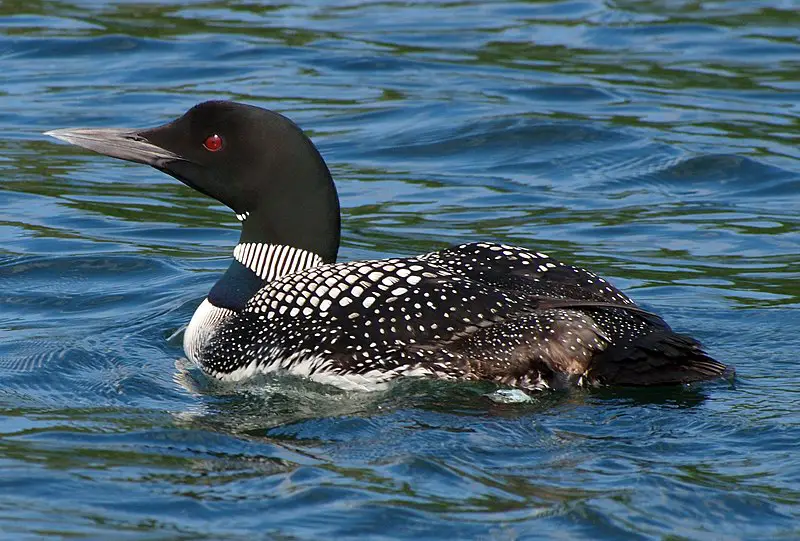
The Common Loon is a beautiful bird found in North America. It has a large black head and neck, with a greenish to purple sheen that stands out against its dark grey upperparts.
The underparts are pure white except for some black on the undertail coverts and vent.
During non-breeding season adults have brown plumage instead of the bright shades they show during breeding season.
They also exhibit unique behaviors such as diving underwater to catch fish or swimming along lakeshores while calling loudly, which is how they got their name “great northern diver”.
With their stunning colors and interesting behavior, it’s no wonder why these birds make up an iconic part of many landscapes across North America.Scientific classification:
| Kingdom | Animalia |
| Phylum | Chordata |
| Class | Aves |
| Order | Gaviiformes |
| Family | Gaviidae |
| Genus | Gavia |
| Species | G. immer |
Also Featured In: Most Common United States Birds, Most Common Songs Birds that Live around You
2. American Coot
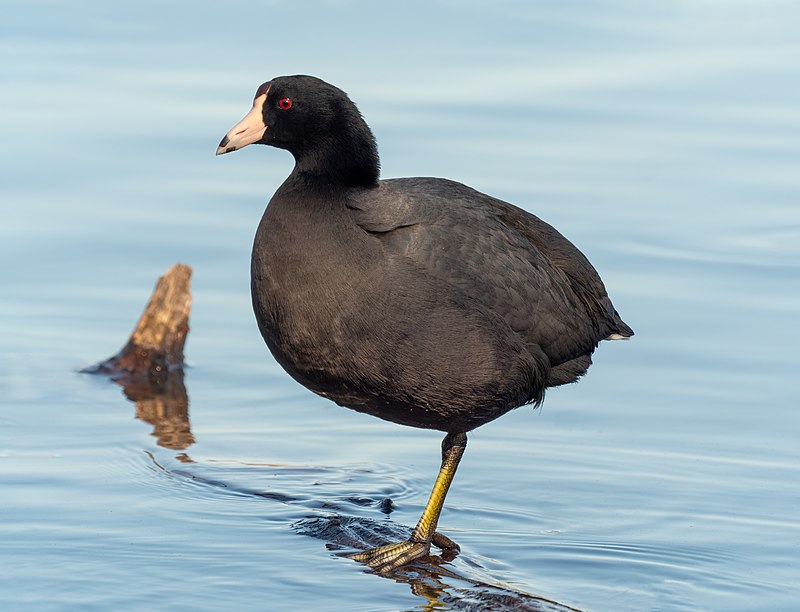
The American coot is a bird of the Rallidae family, commonly mistaken for ducks. However, they are only distantly related and have broad lobed scales on their lower legs and toes that fold back with each step to help them walk on dry land unlike ducks which have webbed feet.
Coots are omnivores who typically live in freshwater marshes, ponds and lakes but can also be found in brackish water habitats or even open oceans during migration season.
They feed mainly on algae and aquatic plants as well as small fish, snails, insects larvae and worms from time to time.
The males display territorial behaviour by chasing away intruders within their territory while females lay eggs mostly.
In floating nests made of vegetation near shorelines or islands among reeds where chicks hatch after about three weeks incubation period before swimming off into adulthood shortly afterwards at 10-12 weeks old.Scientific classification:
| Kingdom | Animalia |
| Phylum | Chordata |
| Class | Aves |
| Order | Gruiformes |
| Family | Rallidae |
| Genus | Fulica |
| Species | F. americana |
Also Featured In: Most Popular Bird Species in North America, Phoenix Birds You Should Know
3. American Wigeon
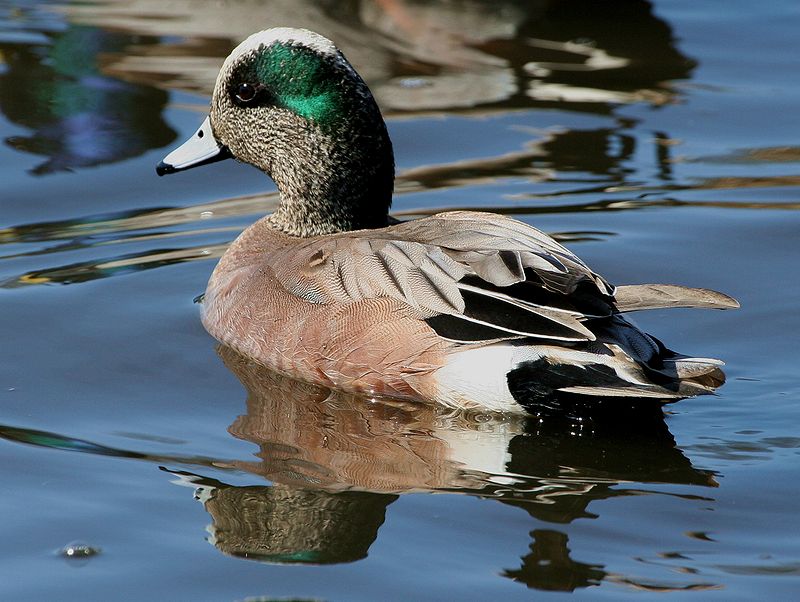
The American Wigeon, also known as the Baldpate, is a species of dabbling duck found throughout North America.
It closely resembles its Eurasian counterpart and was formally described in 1789 by German naturalist Johann Friedrich Gmelin.
This medium-sized bird has an overall grey body with white feathers on its face and belly that give it a distinctive bald appearance.
Its wings are brownish black with green speculum markings on them while the tail is dark brown or black at the base and gradually lightens near tips to become chestnut colored.
The male wigeons have purple patches on their heads during breeding season along with yellow eyes which helps differentiate them from females who have duller colors around their faces instead of bright ones like males possess.Scientific classification:
| Kingdom | Animalia |
| Phylum | Chordata |
| Class | Aves |
| Order | Anseriformes |
| Family | Anatidae |
| Genus | Mareca |
| Species | M. americana |
Also Featured In: Birds in Surrey, Large Birds Live in Idaho
4. Mallard
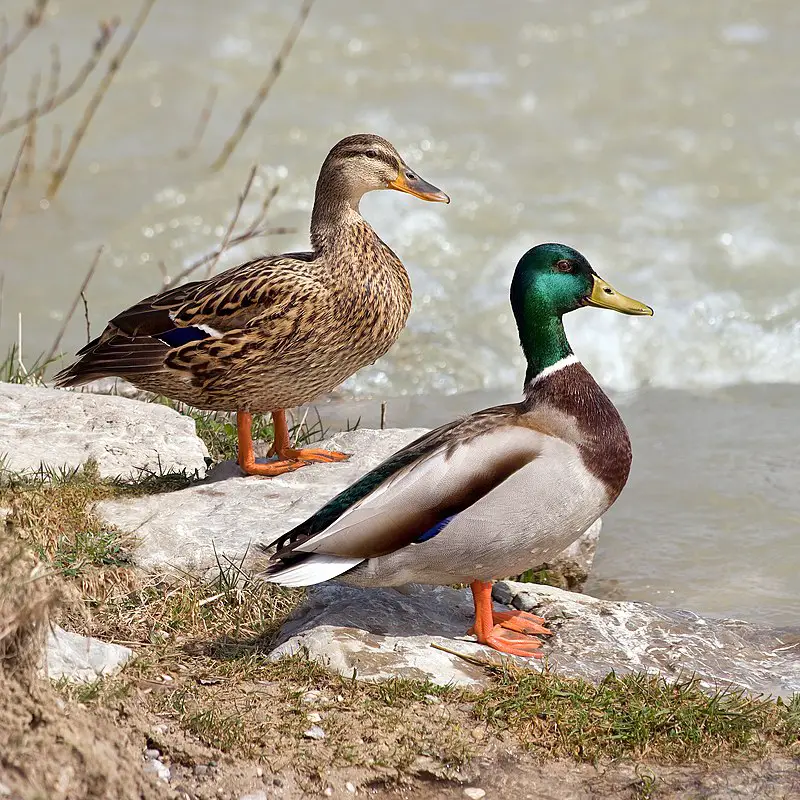
The Mallard is a species of dabbling duck that can be found living in temperate and subtropical regions across the Americas, Eurasia and North Africa.
It has been introduced to other areas such as New Zealand, Australia, Peru, Brazil and South Africa by humans.
This beautiful bird belongs to the Anatinae subfamily of waterfowl family Anatidae. The adult mallards have a glossy green head with white neck ring surrounding.
It along with brownish grey body feathers making them look stunning when they fly away or just sitting in their natural habitat around lakes or ponds.
They are excellent swimmers too due to webbed feet which helps them swim fast underwater while looking for food like aquatic insects etc.. Their loud quacking sound makes them quite popular among nature lovers.Scientific classification:
| Kingdom | Animalia |
| Phylum | Chordata |
| Class | Aves |
| Order | Anseriformes |
| Family | Anatidae |
| Genus | Anas |
| Species | A. platyrhynchos |
Also Featured In: Common Birds in the Cities, Most Common Nature Birds
5. Canada Goose
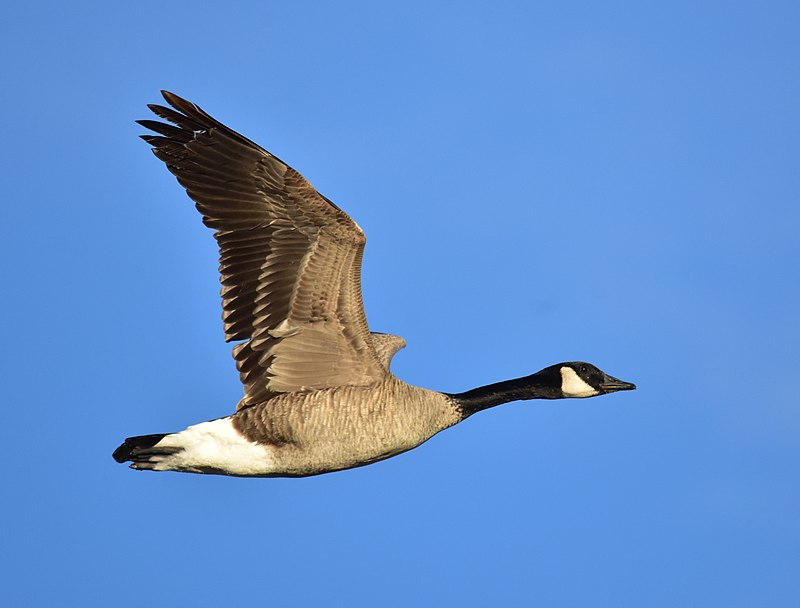
The Canada goose is a majestic bird with a black head and neck, white cheeks, chin and brown body. It’s native to North America but occasionally migrates to northern Europe across the Atlantic.
The species has been introduced in the United Kingdom, Ireland and Finland as well. Canada geese are strong flyers that travel in flocks for protection from predators; they also form monogamous pairs for life.
They feed on grasses or grains near ponds or wetlands where they make their nests of down which incubate eggs during summertime before hatching them out into goslings later on.Scientific classification:
| Kingdom | Animalia |
| Phylum | Chordata |
| Class | Aves |
| Order | Anseriformes |
| Family | Anatidae |
| Genus | Branta |
| Species | B. canadensis |
Also Featured In: Birds Live in Arkansas, Birds that Live in San Francisco Bay Area
6. Shorebirds
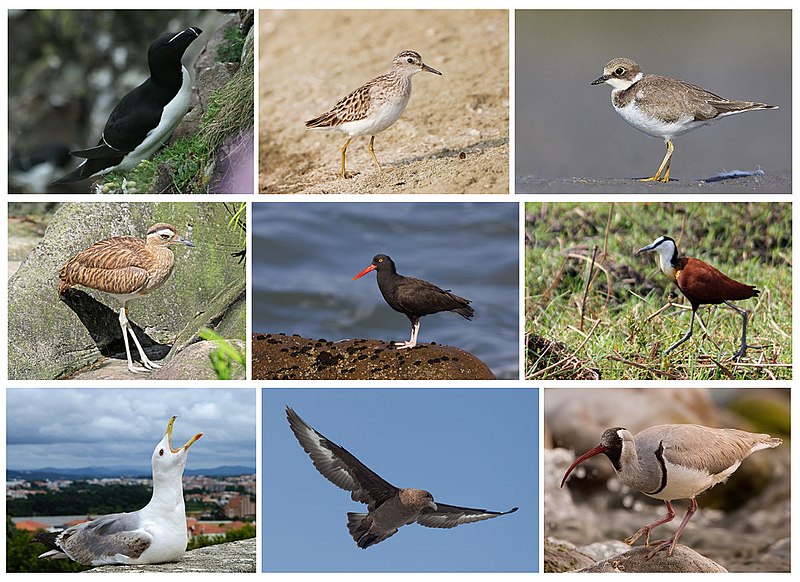
Shorebirds, a diverse group of birds in the Charadriiformes order, are found near water on every continent except Antarctica.
These small to medium-sized birds feed mainly on invertebrates and other small animals but can also be pelagic seabirds or inhabit deserts.
Shorebirds use their long bills to probe mudflats for food like worms and mollusks while some species plunge into the ocean’s depths in search of crustaceans such as crabs and shrimp.
They have strong legs equipped with webbed feet which allow them to move quickly when searching for prey across wetlands, sandbars, beaches and swamps.
Their feathers make them well adapted to life by land or sea due to its hydrophobic nature which helps reduce drag during swimming or flying through windy conditions making it easier for shorebirds survive tough environments around the world.Scientific classification:
| Kingdom | Animalia |
| Phylum | Chordata |
| Class | Aves |
| Infraclass | Neognathae |
| Clade | Neoaves |
| Clade | Gruimorphae |
| Order | Charadriiformes Huxley, 1867 |
Also Featured In: Beautiful Brazilian Birds, Turkey Birds You Should Know
7. Jacanas
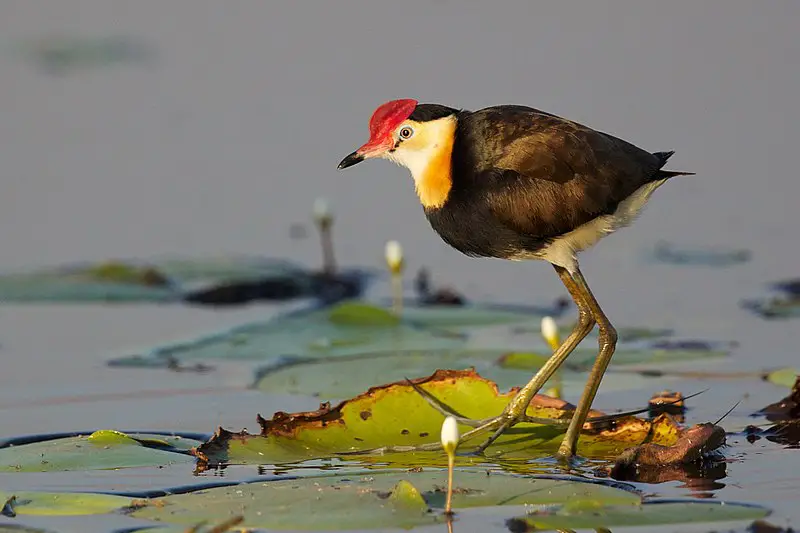
Jacanas are tropical waders belonging to the Jacanidae family. They have distinctive elongated toes and toenails which help them forage on floating or semi-emergent aquatic vegetation.
This adaptation gives them their nickname “Jesus birds” as they seem to be able to walk on water.
The female jacanas are also unique amongst bird species in that they take charge of nest building, incubation and caring for young while males perform courtship displays.
These unusual birds can be found throughout the world’s tropical regions where they inhabit wetlands such as swamps, marshes and shallow lakes with lily pads.
With a wide variety range due their special adaptations these beautiful creatures will surely continue living life at ease around our planet’s warmest waters.Scientific classification:
| Kingdom | Animalia |
| Phylum | Chordata |
| Class | Aves |
| Order | Charadriiformes |
| Suborder | Thinocori |
| Family | Jacanidae Stejneger, 1885 |
Also Featured In: Birds that You’ll Find in Puerto Rico, Birds that Charles Darwin Studied
8. Black-Necked Stilt
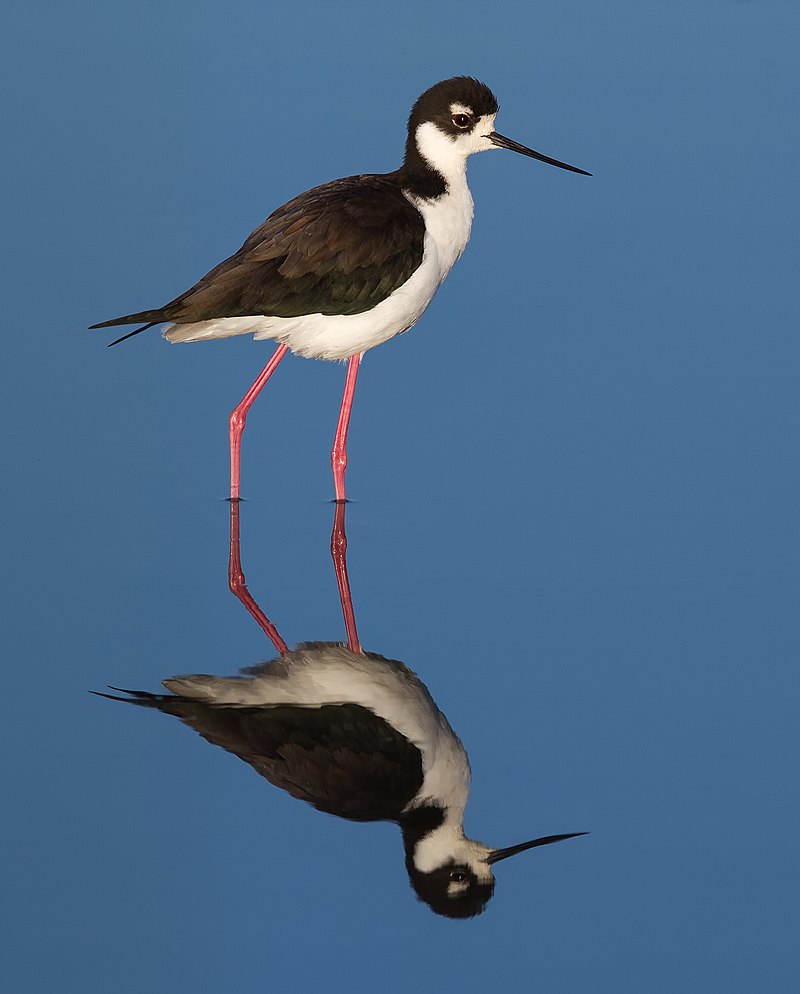
The Black-necked Stilt is an elegant shorebird that can be found from the coastal areas of California to Florida, then south through Central America and Brazil.
It has black upperparts contrasted by long white wings with a glossy sheen. Its striking red eyes are set against its white facial mask while its legs are bright pinkish in coloration.
The Haematopus mexicanus species inhabits marshy wetlands and brackish lagoons where it feeds on insects, crustaceans, small amphibians and fish which they catch using their slender bill or chase after them as they run across the surface of water or mudflats.
This bird typically nests near shallow waters but will use any habitat type if food resources are available nearby making it a highly adaptable species well suited for human altered habitats such as rice fields and sewage ponds.Scientific classification:
| Kingdom | Animalia |
| Phylum | Chordata |
| Class | Aves |
| Order | Charadriiformes |
| Family | Recurvirostridae |
| Genus | Himantopus |
| Species | H. mexicanus |
Also Featured In: Most Common Oahu Birds, Swamps Birds You Should Know
9. Herons
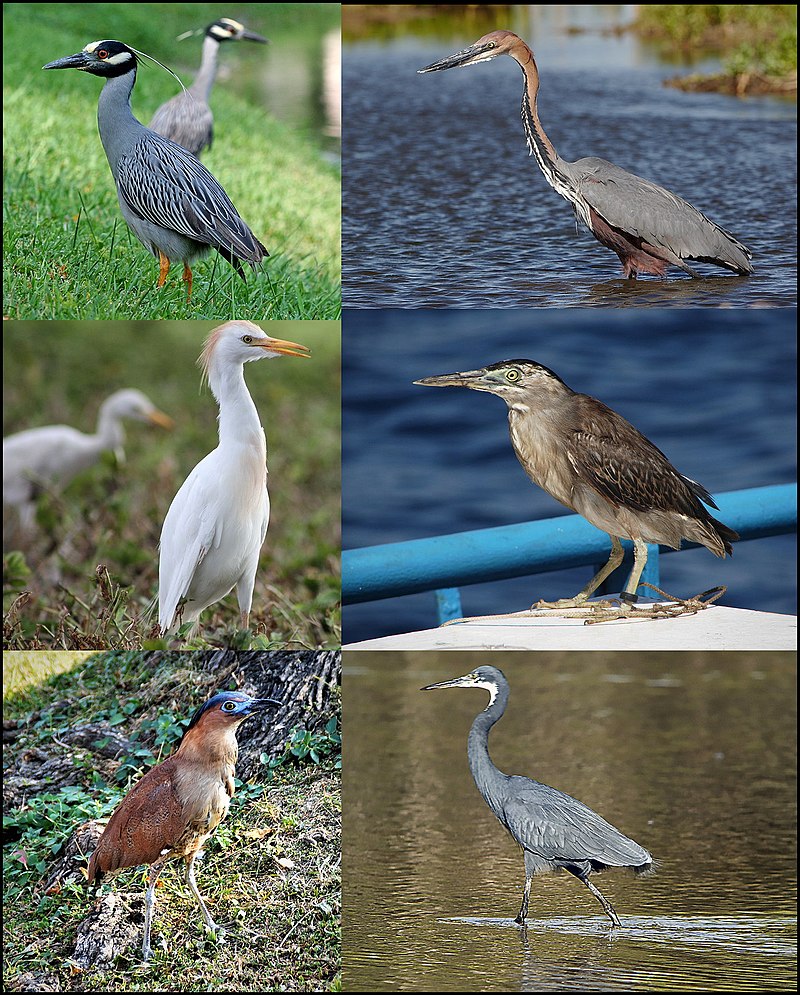
Herons are graceful and elegant birds belonging to the family Ardeidae, with 72 distinct species.
They have long legs and necks that are well-adapted for wading in shallow water like streams or ponds.
Herons can be found near freshwaters as well as along coastal areas worldwide.
Some of these species may also be referred to as egrets, bitterns or zigzag heron/bittern because they belong to certain genera such as Botaurus and Ixobrychus respectively.
These birds stand tall when searching for food by standing still in a shallow body of water while waiting patiently until prey appears before quickly capturing it with their sharp bills.Scientific classification:
| Kingdom | Animalia |
| Phylum | Chordata |
| Class | Aves |
| Order | Pelecaniformes |
| Suborder | Ardei |
| Family | Ardeidae Leach, 1820 |
Also Featured In: Most Common Types of Bangladeshi Birds, Birds You’ll Find in Moldova
10. Darters
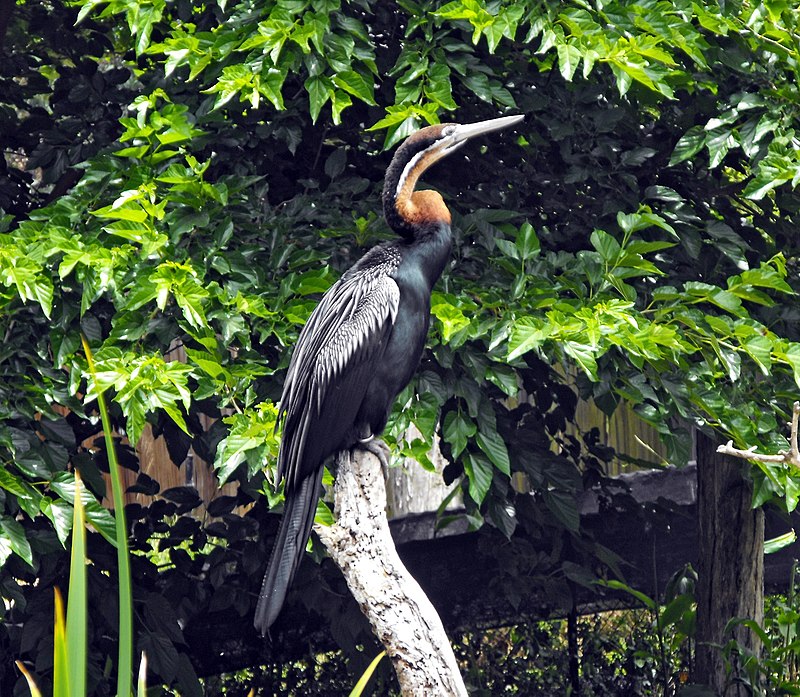
Darters are tropical waterbirds from the family Anhingidae, which includes four species. Three of these species are common and found in multiple locations while one is rarer and classified as near-threatened by IUCN.
Their most notable feature is their long neck which they use to dive into shallow waters for prey such as fish or frogs.
They have a slim body with large wings allowing them to soar high in the sky at great speeds making it difficult for predators to catch them during flight.
Darters also make regular visits to land where they bask in the sun on tree branches or rocky outcroppings.
These birds can be easily identified by their dark feathers, yellowish eyes, and orangey beak – all features that help distinguish them from other birds of similar size and coloration.Scientific classification:
| Kingdom | Animalia |
| Phylum | Chordata |
| Class | Aves |
| Order | Suliformes |
| Family | Anhingidae Reichenbach, 1849[1] |
| Genus | Anhinga Brisson, 1760 |
Also Featured In: Birds of Goa, South Australian Birds
11. Ducks
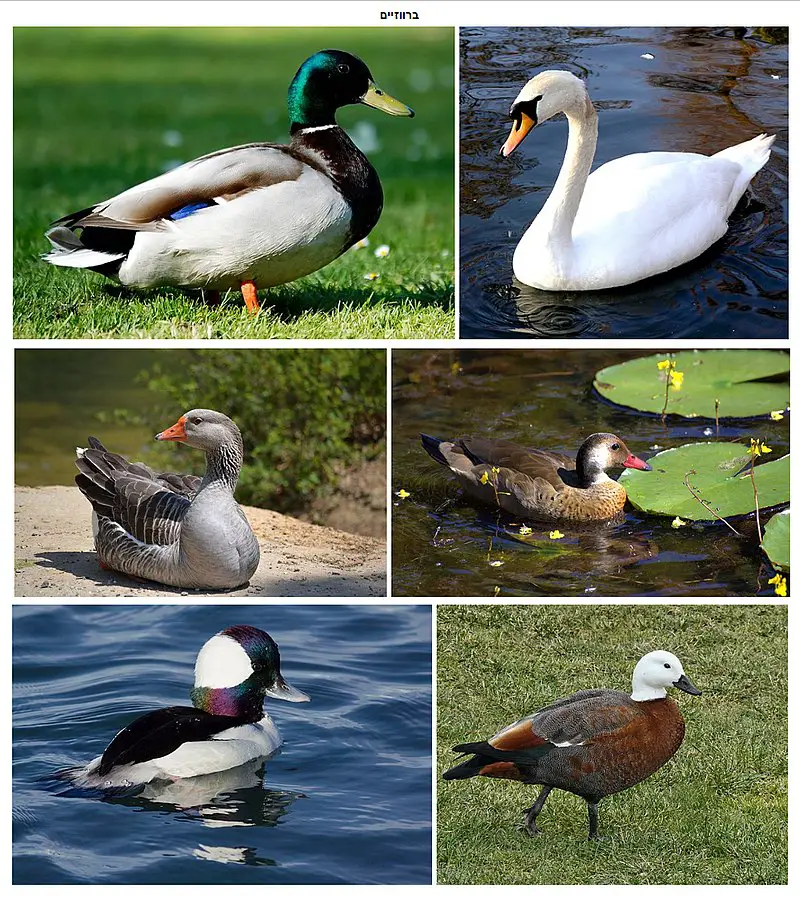
Ducks are water birds belonging to the family of Anatidae. They have a worldwide distribution except Antarctica and are highly adapted for swimming, floating on water surface or in shallow depths.
Ducks come in various sizes ranging from small teals to large swans with around 174 species found across 43 genera.
Their feathers make them waterproof enabling ducks to stay afloat even in stormy waters while their webbed feet allow them to swim gracefully underwater.
Ducks usually feed by filtering food items such as insects, molluscs and crustaceans through their bills but some also graze on land vegetation like grasses & grains depending upon availability of resources at different locations they inhabit.Scientific classification:
| Kingdom | Animalia |
| Phylum | Chordata |
| Class | Aves |
| Order | Anseriformes |
| Suborder | Anseres |
| Superfamily | Anatoidea |
| Family | Anatidae Leach, 1820 |
Also Featured In: Birds of Sweden, Birds that Live in Croatia
12. Pied-Billed Grebe
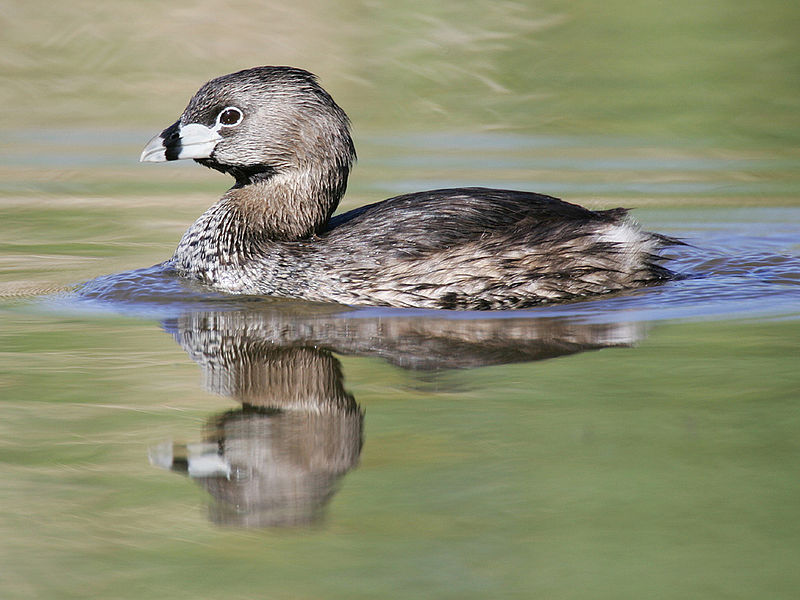
The Pied-billed Grebe is a water bird found in ponds throughout the Americas. It has earned many nicknames, including American dabchick, rail, and Carolina grebe.
This species of grebe can be recognized by its distinctive bill which is pied or mottled with black and white markings.
Its brownish body is also covered in dark spots as well as having long legs for swimming underwater to catch food such as aquatic insects and crustaceans.
The Pied-billed Grebes are monogamous birds that pair up during breeding season from spring to summer where they build their nests together on vegetation near the shoreline of lakes or slow moving rivers.
These birds are solitary outside of mating season but will form small flocks when migrating south for winter months.Scientific classification:
| Kingdom | Animalia |
| Phylum | Chordata |
| Class | Aves |
| Order | Podicipediformes |
| Family | Podicipedidae |
| Genus | Podilymbus |
| Species | P. podiceps |
Also Featured In: Top Birds Found in Mexico, Birds in Calgary You’ll Love to See
13. White-Faced Ibis
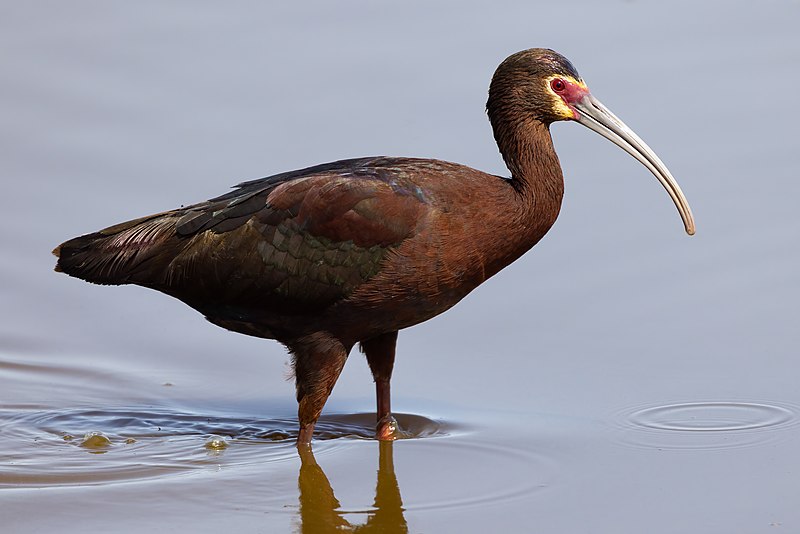
The White-faced Ibis is a species of wading bird belonging to the ibis family. It breeds in marshes, nesting on low trees or bushes.
The breeding range for this species stretches from western United States south through Mexico, and from southeastern Brazil and Bolivia all the way down to central Argentina and along the coast of Chile.
Its wintering grounds include coastal California, northern Arizona, New Mexico as well as Central America; it also occasionally occurs further north than usual due to favorable conditions.
This beautiful bird has white plumage with bronze wings that shine when seen under sunlight. Furthermore, its head is adorned by an unmistakable white face patch which gives it its name—White-faced Ibis.Scientific classification:
| Kingdom | Animalia |
| Phylum | Chordata |
| Class | Aves |
| Order | Pelecaniformes |
| Family | Threskiornithidae |
| Genus | Plegadis |
| Species | P. chihi |
Also Featured In: Most Common Oaxaca Birds, Birds that Live in Tabasco
14. Pelecaniformes
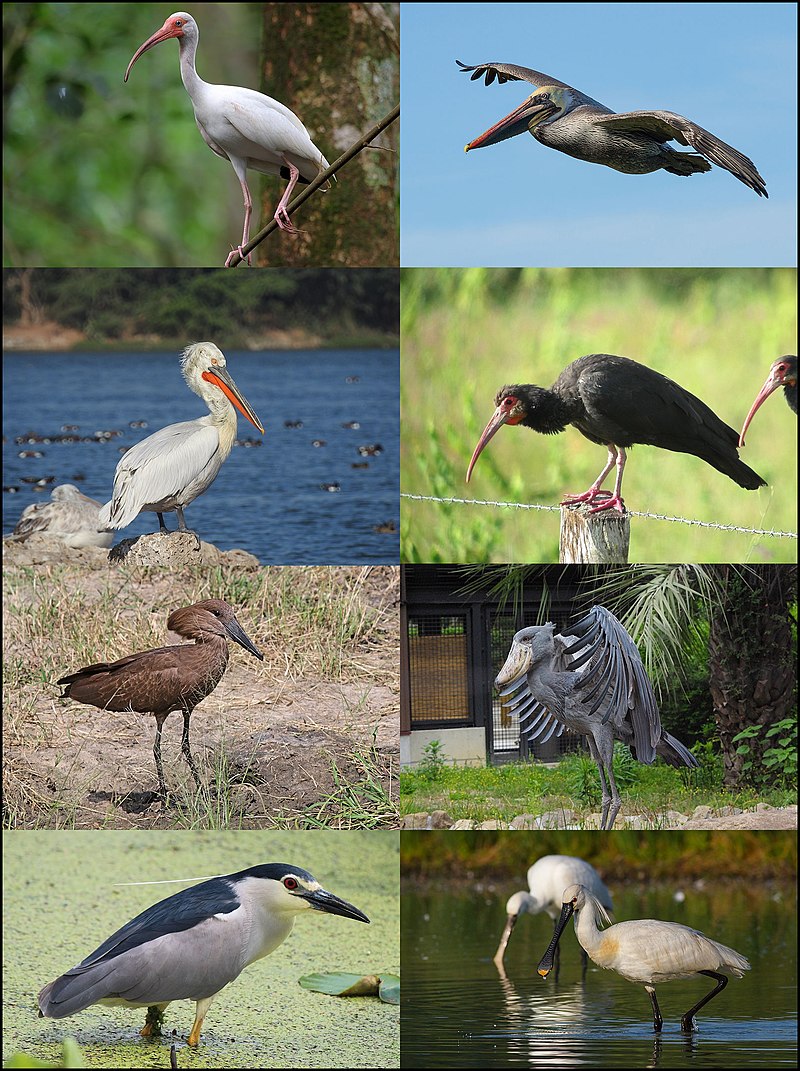
Pelecaniformes are a diverse order of waterbirds found all around the world. They vary in size, but most species are medium to large birds with webbed feet and a bare throat patch (gular patch).
Their nostrils have evolved into non-functional slits. Some examples include pelicans, gannets, cormorants and frigatebirds which can be found near coasts or on inland waters such as lakes or rivers.
Many Pelecaniforms fish for food by diving underwater from the air – some even swim underwater.
The diet of these birds consists mainly of small fishes although they may also eat mollusks, crustaceans and other aquatic creatures depending on their location.
All in all, Pelecaniformes make an important contribution to our planet’s biodiversity by keeping populations of fish under control while providing us with great views when we’re out exploring nature.Scientific classification:
| Kingdom | Animalia |
| Phylum | Chordata |
| Class | Aves |
| Clade | Aequornithes |
| Order | Pelecaniformes Sharpe, 1891 |
Also Featured In: Birds that Live in Guyana, Common Species of Birds
15. Green Heron
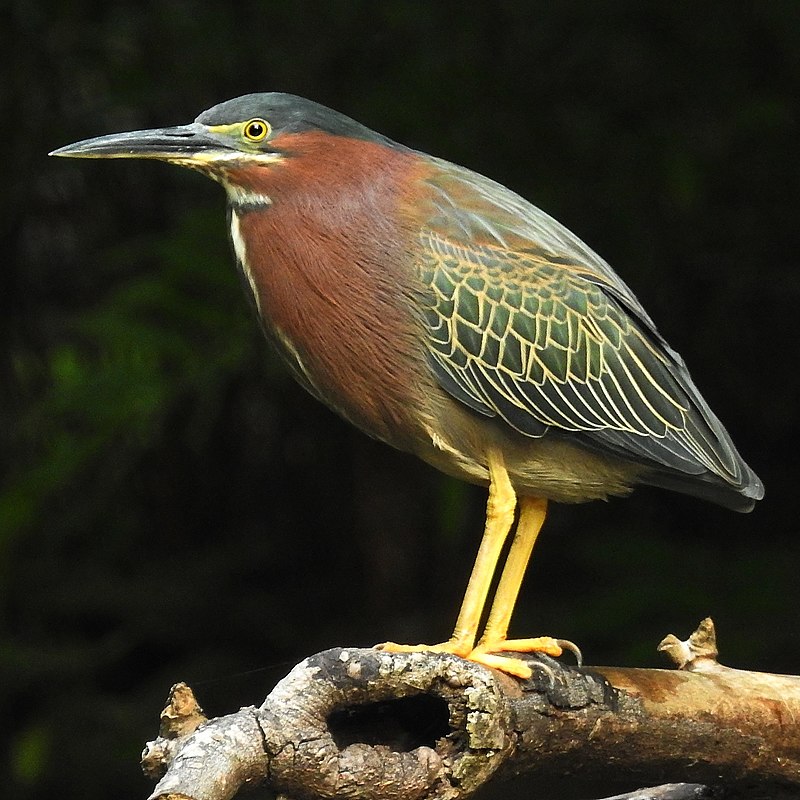
The Green Heron (Butorides virescens) is a small heron found throughout North and Central America.
It’s scientific name comes from Middle English ‘butor’ meaning bittern, combined with the Latin term for its distinctive greenish color – ‘virescens’.
For many years it was considered to be part of the same species as the Striated Heron (Butorides striata), commonly referred to as “green-backed herons”.
The nominate subspecies inhabits wetlands across much of this range, where they can be spotted stalking about in shallow water looking for fish or frogs on which to feed.
They are fascinating wading birds that have even been known to use tools such as sticks or baited lines when fishing.Scientific classification:
| Kingdom | Animalia |
| Phylum | Chordata |
| Class | Aves |
| Order | Pelecaniformes |
| Family | Ardeidae |
| Genus | Butorides |
| Species | B. virescens |
Also Featured In: Water Vermont Birds You Need to See, Green Birds Commonly Found in Florida
16. Grey Heron
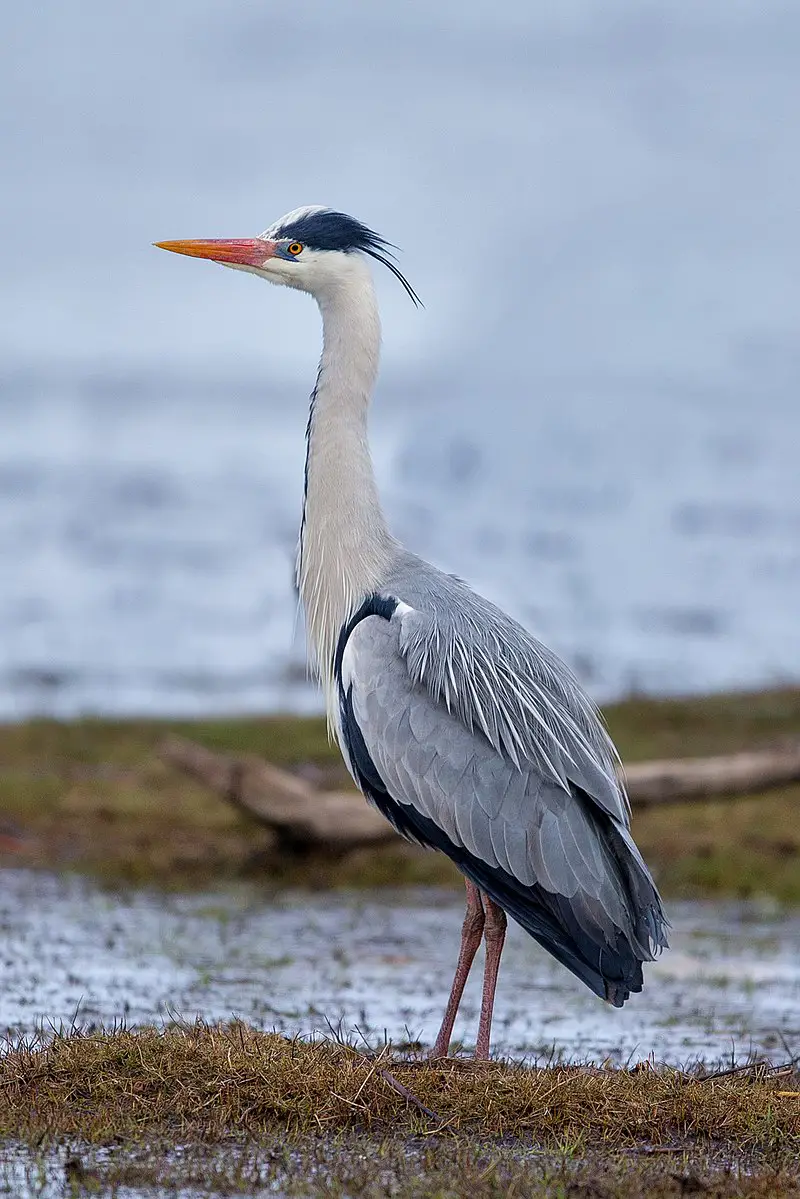
The grey heron is a majestic bird found in temperate regions of Europe, Asia and parts of Africa. It has long legs to wade through the shallow waters where it feeds on aquatic creatures such as frogs, fish and insects.
In wintertime some migrate southwards but others stay put in their natural habitats; lakes, rivers and marshes. They can also be spotted near coasts or along estuaries.
Grey Herons have beautiful blue-grey feathers and an impressive wingspan that makes them stand out from other birds when they soar gracefully across the sky.
These graceful creatures are not only easy on the eye but wise hunters too.Scientific classification:
| Kingdom | Animalia |
| Phylum | Chordata |
| Class | Aves |
| Order | Pelecaniformes |
| Family | Ardeidae |
| Genus | Ardea |
| Species | A. cinerea |
Also Featured In: Common Birds in Japan, Most Common Romanian Birds
17. Grebes
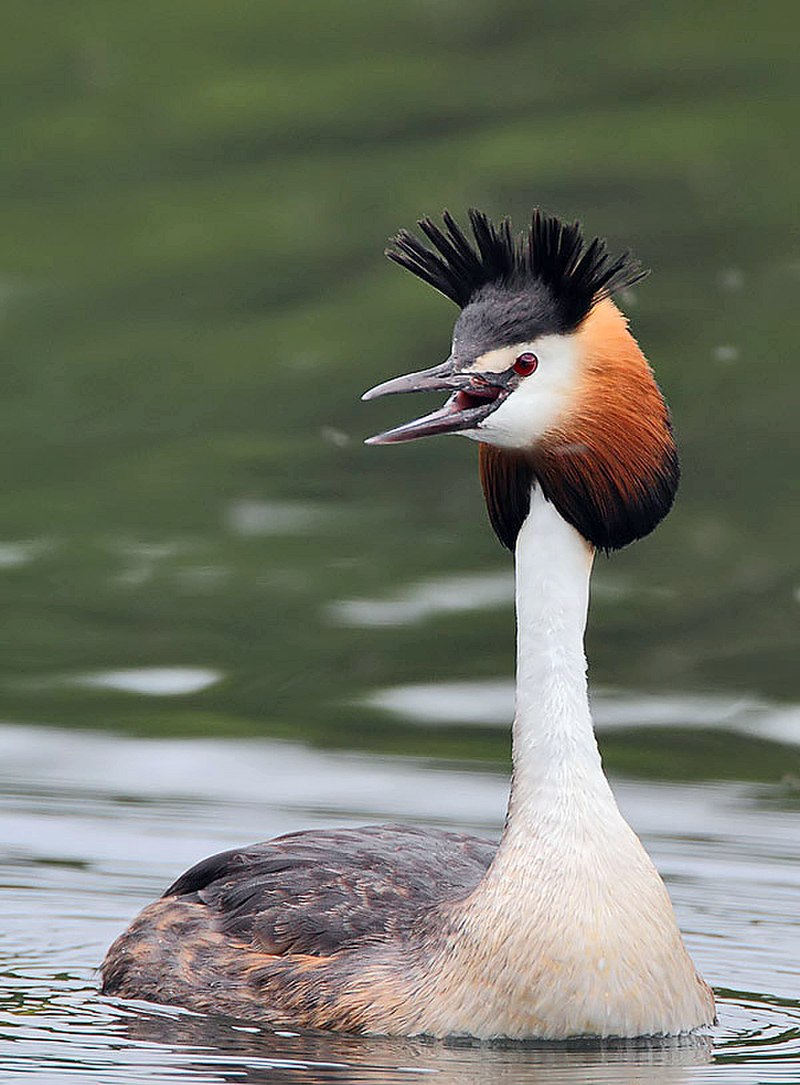
Grebes are a type of diving bird found in freshwater habitats around the world. They belong to the order Podicipediformes and have 22 species that exist across six genera.
Some species can also be found in marine environments during their migration or winter season, and some even live flightless lives on stable lakes.
Grebes vary greatly between regions; for example, they range from 4-32 inches long with anywhere from 8-30 ounces of weight depending on which species it is.
Their plumage may be black, browns/grays or whites but usually consist of bright colors such as yellows, blues and greens while underwater they use these feathers to help them streamline through the water quickly.Scientific classification:
| Kingdom | Animalia |
| Phylum | Chordata |
| Class | Aves |
| Clade | Neoaves |
| Clade | Mirandornithes |
| Order | Podicipediformes Fürbringer, 1888 |
| Family | Podicipedidae Bonaparte, 1831 |
Also Featured In: Ukrainian Birds You Should Know, Birds That Live in Iraq
18. Anseriformes
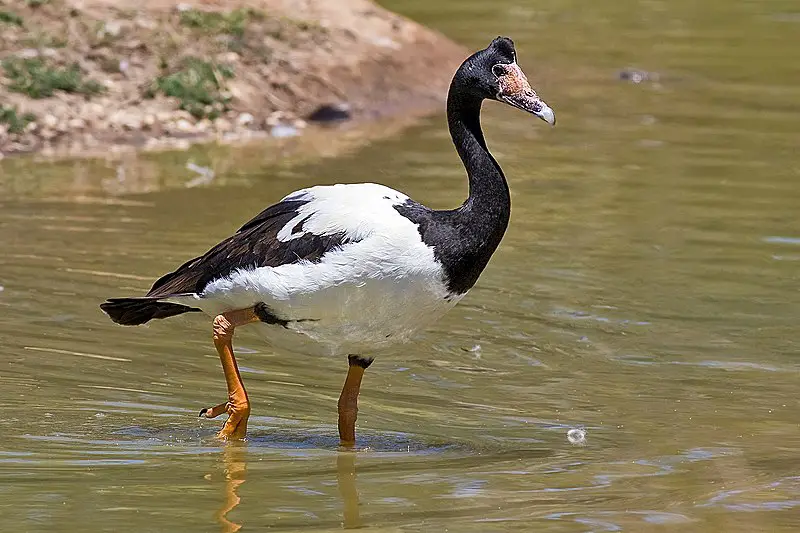
Anseriformes are a group of waterfowl birds that includes ducks, geese and swans. With over 180 living species in three families, these birds have adapted to live an aquatic life with great skill.
They can be found near lakes or rivers foraging for food along the shoreline or diving underwater pursuing prey like fish and mollusks.
Their long legs help them move through deeper waters as they swim gracefully across the surface looking for food.
Anhimidae (screamers) often utilize their sharp voices to communicate with each other while Anatidae use bill-dipping displays when courting potential mates during mating season. These beautiful birds will never cease to amaze us.Scientific classification:
| Kingdom | Animalia |
| Phylum | Chordata |
| Class | Aves |
| Clade | Anserimorphae |
| Order | Anseriformes Wagler, 1831 |
Also Featured In: Birds Commonly Found in New York, Common Birds in Saskatchewan
19. Cattle Egret
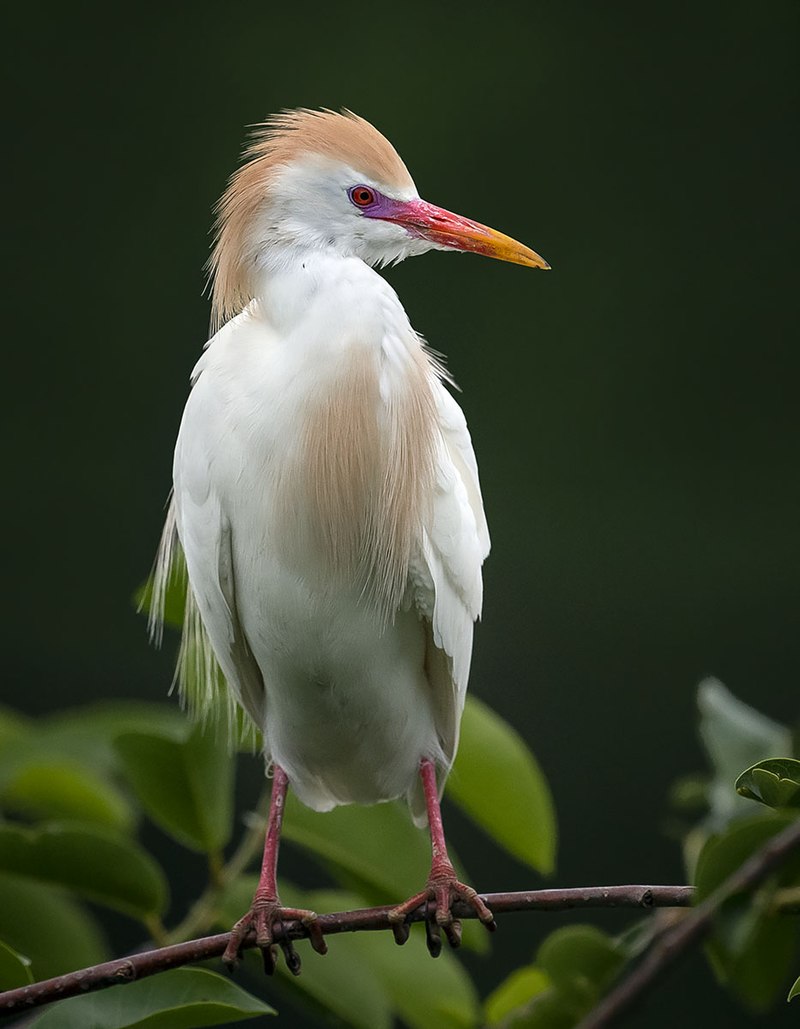
The Cattle Egret is a heron of the family Ardeidae found around the world in tropical, subtropical and warm temperate areas. It has two subspecies: western cattle egret and eastern cattle egret.
They have white plumage with buff plumes on their head, neck and back. The beak is yellowish-orange with black tip while legs are orange or yellow coloured depending on species variation.
This bird usually feeds near large herds of animals such as cows, horses etc., where it finds plenty of insects to eat like grasshoppers, crickets etc..
Its presence benefits these animals by removing ectoparasites from them which leads to healthier livestock population.
It nests colonially in trees or shrubs located close to water bodies during breeding season which generally takes place between March-June every year.Scientific classification:
| Kingdom | Animalia |
| Phylum | Chordata |
| Class | Aves |
| Order | Pelecaniformes |
| Family | Ardeidae |
| Genus | Bubulcus Bonaparte, 1855 |
| Species | B. ibis |
Also Featured In: Egyptian Birds, Asian Birds
20. Great Cormorant
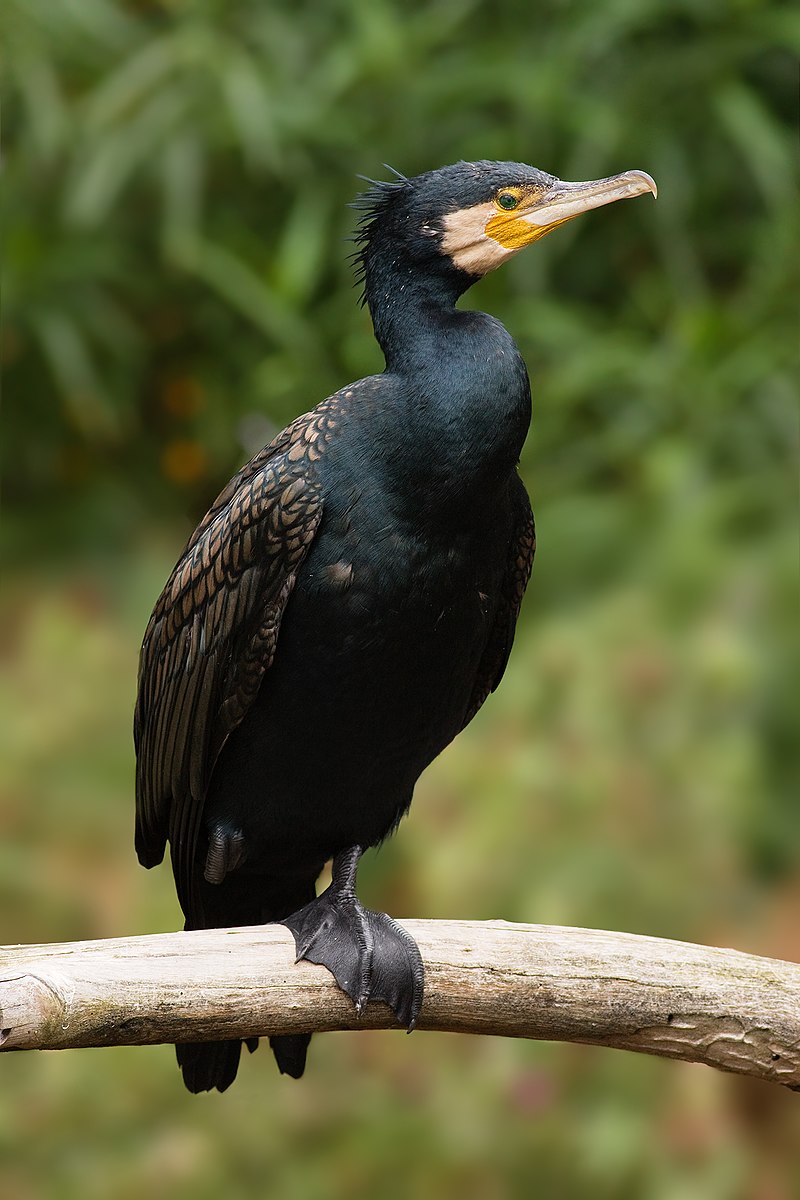
The Great Cormorant is a large seabird belonging to the cormorant family. It has many names, including Black Shag in New Zealand and Large Cormorant in India.
Its striking black feathers make it easy to recognise along coastlines or near bodies of water. The bird can measure up to 1 metre long with a wingspan of around two metres and weighs roughly 3 kilograms.
In flight, its neck is stretched out straight ahead while its bill points downwards – an unmistakable sight for any keen observer.
Cormorants are strong swimmers and excellent divers, frequently going underwater in search of food such as fish or crustaceans that they scavenge from the ocean floor.
They live primarily on coasts but have also been seen inland where there are suitable waterways available – providing another opportunity for nature lovers hoping to catch a glimpse of this impressive species.Scientific classification:
| Kingdom | Animalia |
| Phylum | Chordata |
| Class | Aves |
| Order | Suliformes |
| Family | Phalacrocoracidae |
| Genus | Phalacrocorax |
| Species | P. carbo |
Also Featured In: Native Birds Of Germany, Common Estonian Birds
21. Eurasian Teal
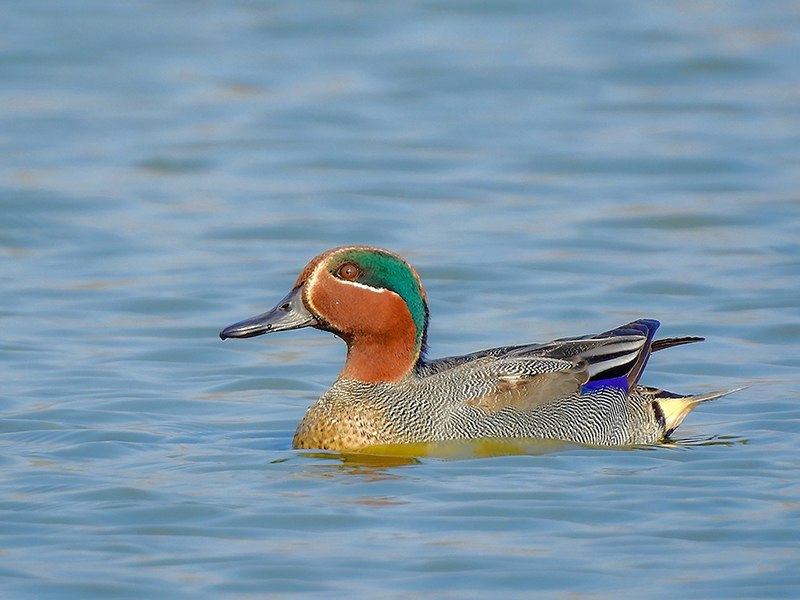
The Eurasian teal, also known as the common teal or the Eurasian green-winged teal, is a small dabbling duck that inhabits temperate Europe and Asia.
It has an unmistakable blue-green colouring which gives it its name.
During winter months they migrate south in large flocks to areas with warmer climates where there is more food available for them to feed on.
The Eurasian Teals are highly social birds; they often congregate in groups of hundreds or even thousands during migration periods.
They mostly feed on aquatic vegetation such as grasses and weeds but will occasionally hunt insects too.
These ducks make beautiful sights when flying over lakes or streams, their wings producing a distinctive whistling sound while they glide across the sky.Scientific classification:
| Kingdom | Animalia |
| Phylum | Chordata |
| Class | Aves |
| Order | Anseriformes |
| Family | Anatidae |
| Genus | Anas |
| Species | A. crecca |
Also Featured In: Birds of United Kingdom, Flocks Birds around Us
22. Cormorants
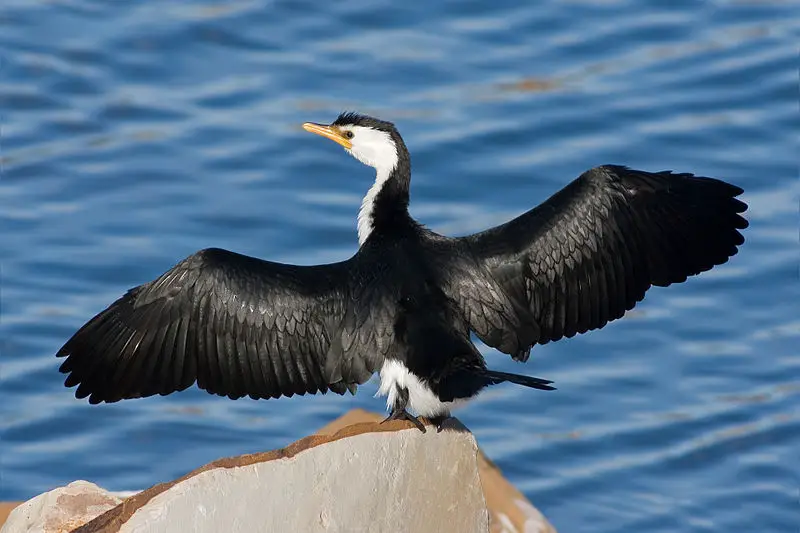
Cormorants are a family of aquatic birds found around the world. They include 40 species, such as great cormorants and common shags.
In Britain, these two species are the most commonly seen in their natural habitats.
Cormorants have long necks, webbed feet and can be identified by their glossy black feathers which they use to help them swim through water with ease as they hunt for food like fish or crustaceans.
They have an impressive wingspan often reaching up to five feet across when fully extended.
Despite being strong swimmers, these birds also enjoy spending time perched on rocks near rivers or shorelines where they will preen themselves in order to keep clean and dry during cooler weather conditionsScientific classification:
| Kingdom | Animalia |
| Phylum | Chordata |
| Class | Aves |
| Order | Suliformes |
| Family | Phalacrocoracidae Reichenbach, 1850 |
Also Featured In: Most common Birds in France, Italian Birds You Should Know
23. Great Egret
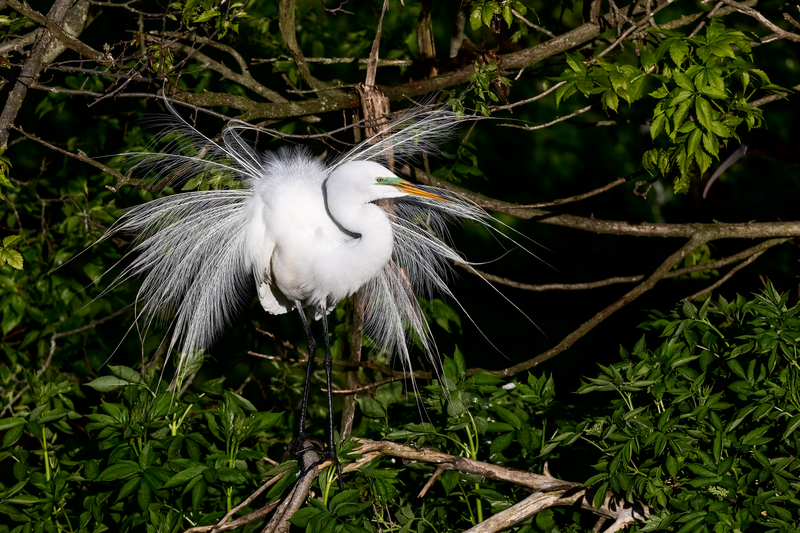
The Great Egret is a large, white bird found in many regions of the world. It has four subspecies that reside across Asia, Africa, Americas and southern Europe.
This species usually lives near bodies of water such as lakes and marshes. They are also now starting to spread into more northern areas of Europe due to climate change.
These birds have long yellow legs with an impressive wingspan for their size which allows them to soar majestically through the sky hunting for fish or amphibians in shallow waters below.
Their feathers have been used historically by Native Americans as part of traditional garments or ceremonies but this practice should be avoided today so these amazing creatures can thrive without harm from humans.Scientific classification:
| Kingdom | Animalia |
| Phylum | Chordata |
| Class | Aves |
| Order | Pelecaniformes |
| Family | Ardeidae |
| Genus | Ardea |
| Species | A. alba |
Also Featured In: Birds that Live around Southwest Florida, Spiritual Birds
24. Black-Necked Grebe

The Black-necked Grebe is a beautiful water bird belonging to the grebe family. It has an ochre coloured plumage with distinctive features which include extending behind its eyes and over its ear coverts.
The upper parts of this species are black, while their underparts and neck are white in colour.
During breeding season, males develop a dark grey crown on top of their head along with bright yellow facial stripes that run from the beak down to it’s chest area.
These birds feed mainly by diving underwater for insects, crustaceans, larvae, molluscs as well as small fish that they find in shallow waters or wetlands near freshwater lakes or streams.
They can often be spotted swimming alone but during winter months gather together creating large flocks due to mating activity taking place at these times.Scientific classification:
| Kingdom | Animalia |
| Phylum | Chordata |
| Class | Aves |
| Order | Podicipediformes |
| Family | Podicipedidae |
| Genus | Podiceps |
| Species | P. nigricollis |
Also Featured In: Birds Live in Tunisia, Common Slovakian Birds
25. Rail
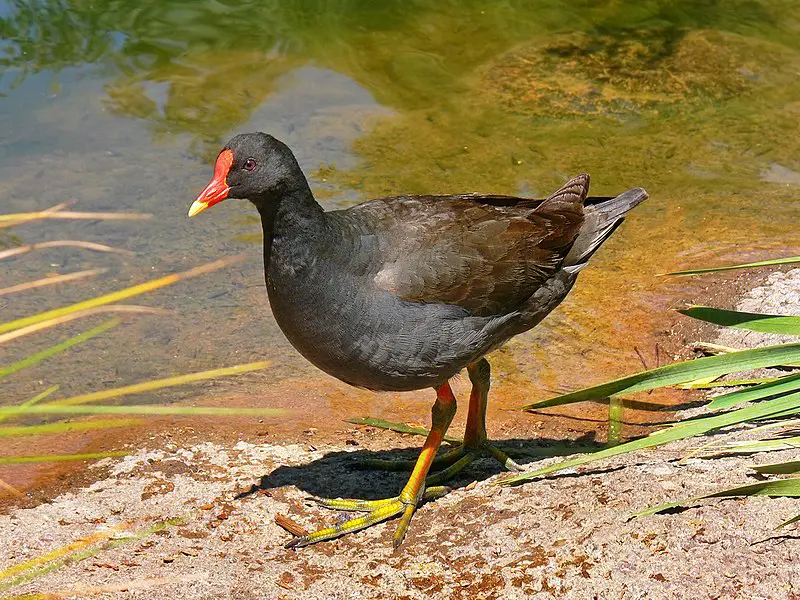
Rails are a diverse family of birds, ranging from small to medium size and living in habitats across the world.
They can be found around wetlands, as well as any other land-based environment except for dry deserts, polar regions or areas with persistent snow cover.
These ground-dwellers have short legs and long toes that help them maneuver through wetland vegetation easily.
Tey typically feed on insects and aquatic invertebrates but will also eat seeds and berries when available.
Species such as coots, crakes and gallinules have evolved different bill shapes to allow them to navigate their environments more efficiently while searching for food.
Rails live both alone or in pairs depending on the species; some migrate seasonally while others remain at one location year round.Scientific classification:
| Kingdom | Animalia |
| Phylum | Chordata |
| Class | Aves |
| Order | Gruiformes |
| Family | Rallidae Rafinesque, 1815 |
Also Featured In: Common Denmark Birds, Birds that Live in Tamil Nadu
26. Mute Swan
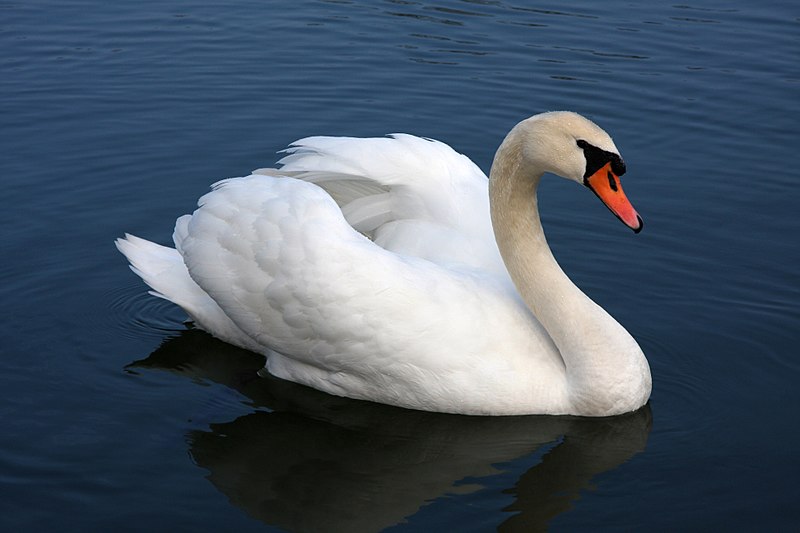
The Mute Swan is a species of swan belonging to the waterfowl family Anatidae. It can be found in much of Eurosiberia, as well as North America, Australasia and southern Africa where it has been introduced.
The ‘mute’ part of its name comes from its soft call which is more muffled than that of other swans.
They have an almost entirely white plumage with black legs and feet and an orange bill with a distinctive knob at the base.
These striking birds are large in size reaching up to 1 metre tall when fully grown with wingspans reaching 3 metres or more.
In flight they hold their necks arched gracefully above their body while beating powerful wings slowly through the air – creating quite a spectacle.Scientific classification:
| Kingdom | Animalia |
| Phylum | Chordata |
| Class | Aves |
| Order | Anseriformes |
| Family | Anatidae |
| Genus | Cygnus |
| Species | C. olor |
Also Featured In: Most Common Lithuanian Birds, European Birds
27. Stork
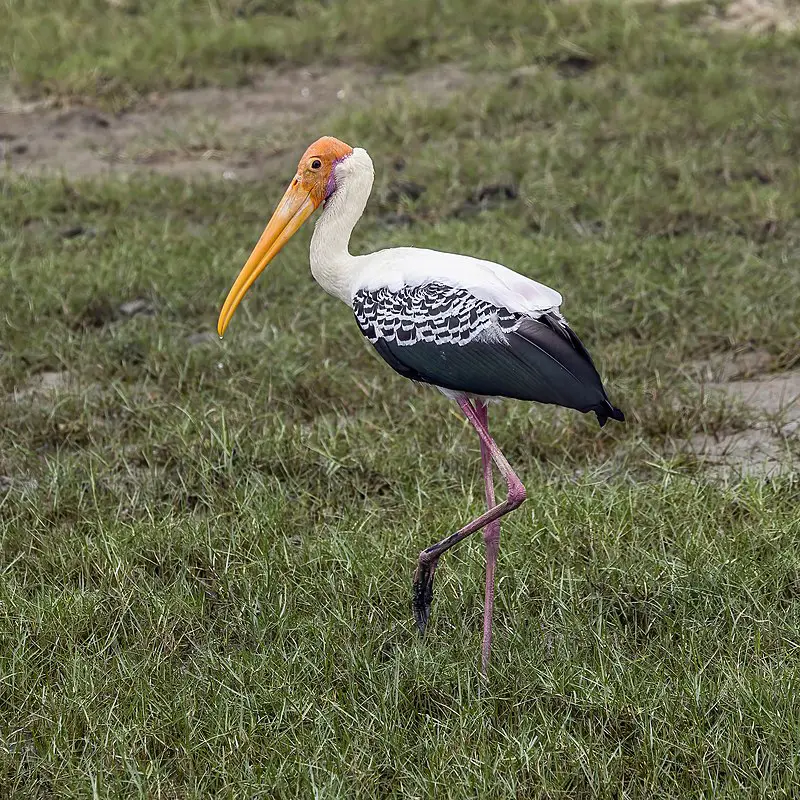
Storks are majestic birds, easily recognizable with their long necks and legs. They belong to the family Ciconiidae, making up the order Ciconiiformes.
Storks inhabit many areas around the world but generally prefer drier habitats than other wading birds like herons or ibises which have been moved to separate orders.
Despite being large in size they can be quite graceful in flight as well as when hunting for food such as insects, small mammals and reptiles near shallow waters.
During nesting season stork pairs build nests on high trees or platforms made of sticks and twigs where they lay eggs that hatch after about a month of incubation time by both parents taking turns sitting on them warmly until hatching day.Scientific classification:
| Kingdom | Animalia |
| Phylum | Chordata |
| Class | Aves |
| Clade | Aequornithes |
| Order | Ciconiiformes Bonaparte, 1854[1] |
| Family | Ciconiidae J. E. Gray, 1840[1] |
Also Featured In: Native South Korean Birds, Bulgarian Birds
28. Glossy Ibis
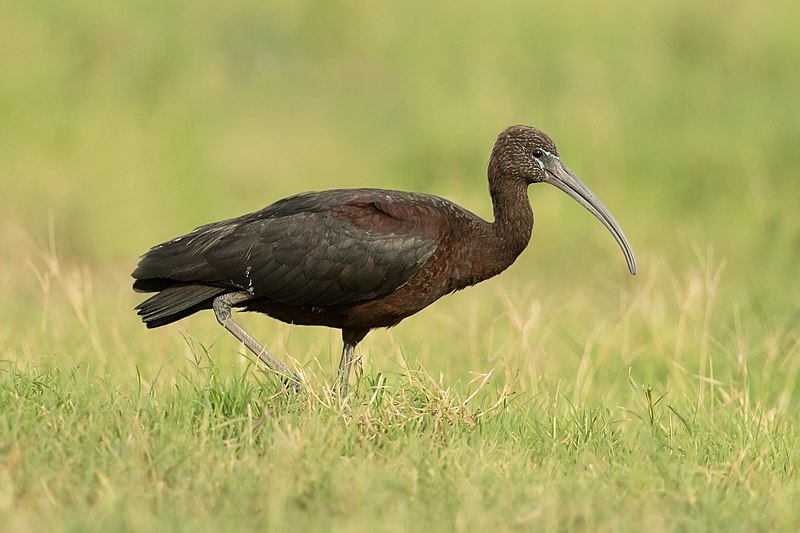
The Glossy Ibis is a water bird that belongs to the family Threskiornithidae. It has an unique bill in the shape of a sickle, which gave it its scientific name – Plegadis falcinellus.
It can be found widely across Europe, Asia and Africa, with scattered nesting sites in warm regions.
Its feathers are black-brown on top and chestnut brown from below; their wings have glossy greenish-purple sheen when seen from afar.
They mainly feed on small insects like grasshoppers, spiders or earthworms as well as crustaceans or amphibians caught while wading through shallow waters.
During breeding season they also consume plant material such as rice grains or corn kernels provided by humans near habitat areas where they nest.Scientific classification:
| Kingdom | Animalia |
| Phylum | Chordata |
| Class | Aves |
| Order | Pelecaniformes |
| Family | Threskiornithidae |
| Genus | Plegadis |
| Species | P. falcinellus |
Also Featured In: Uganda Birds Species, Common Uzbekistan Birds
29. Eurasian Coot
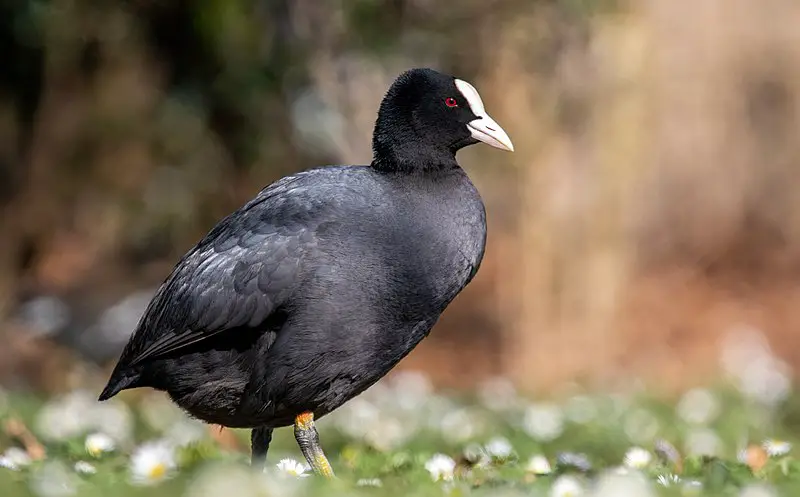
The Eurasian Coot is a water bird belonging to the Rallidae family. It has an overall slaty-black body with a glossy black head and white bill, along with a white frontal shield.
Both male and female coots look similar in appearance. This species can be found across Europe, Asia, Australia, New Zealand and parts of North Africa – making it quite widespread.
In terms of behavior they usually feed on aquatic plants as well as insects while swimming or walking on land near bodies of water such as ponds or lakes.
They are also known for their aggressive nature when defending nesting sites from other birds during breeding season.Scientific classification:
| Kingdom | Animalia |
| Phylum | Chordata |
| Class | Aves |
| Order | Gruiformes |
| Family | Rallidae |
| Genus | Fulica |
| Species | F. atra |
Also Featured In: Birds of Poland, Belarus Birds You Should Know
30. Loons
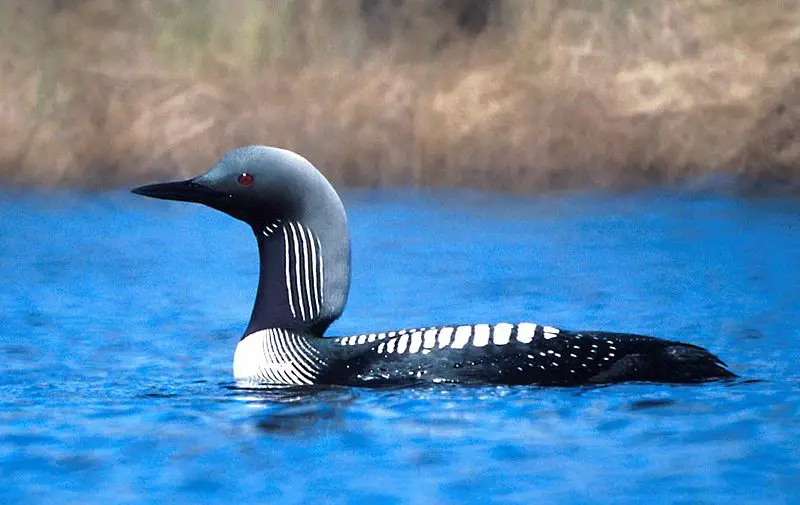
Loons are an aquatic bird found in both North America and northern Eurasia. They can be identified by their size, which is similar to that of large ducks or small geese.
When swimming, loons resemble these birds in shape as well as movement.
Unlike other waterfowl however, they have pointed bills with serrated edges and feet set far back on their bodies; this makes them excellent swimmers but hinders the ability to walk on land properly.
Loons feed mainly on fish but also eat insects and crustaceans when available.
In addition to being a common sight around lakes during warmer months, many species migrate south for winter where they live near coastal waters until returning again in springtime.Scientific classification:
| Kingdom | Animalia |
| Phylum | Chordata |
| Class | Aves |
| Order | Gaviiformes |
| Family | Gaviidae Coues, 1903[1] |
| Genus | Gavia Forster, 1788 |
Also Featured In: Common Birds in Canada, Most Common Scotland Birds
31. Great Blue Heron
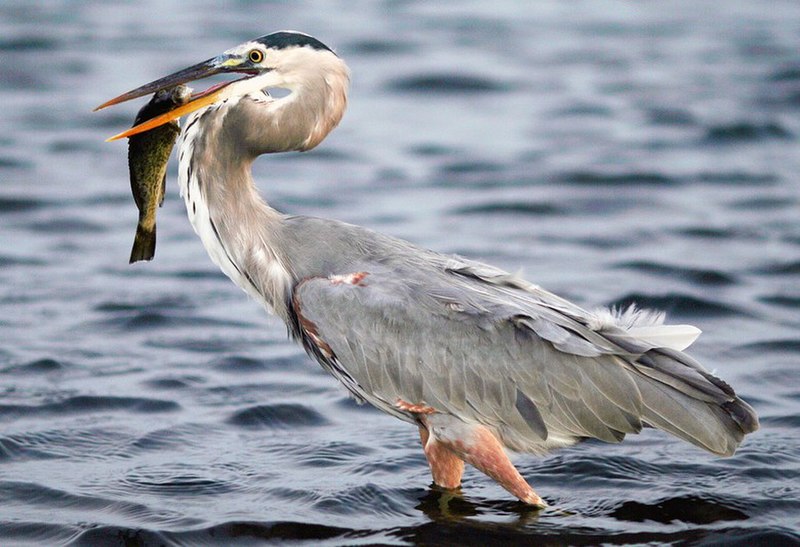
The Great Blue Heron is a majestic wading bird found in many parts of North America, Central America, the Caribbean and even as far away as the Galapagos Islands.
It has an impressive wingspan which can reach up to six feet wide. Its feathers are mainly bluish-gray with brownish streaks on both its neck and chest while its head displays white plumes.
The adult herons can also be identified by their yellow bill and legs.
They live near bodies of water such as lakes, marshes or rivers where they feed on fish using a spear like motion with their sharp bills.
An all-white population exists only in south Florida and the Florida Keys making it quite unique.Scientific classification:
| Kingdom | Animalia |
| Phylum | Chordata |
| Class | Aves |
| Order | Pelecaniformes |
| Family | Ardeidae |
| Genus | Ardea |
| Species | A. herodias |
Also Featured In: Birds That Live in Colorado, Blue Birds You’ll Found around Us
32. Pelican
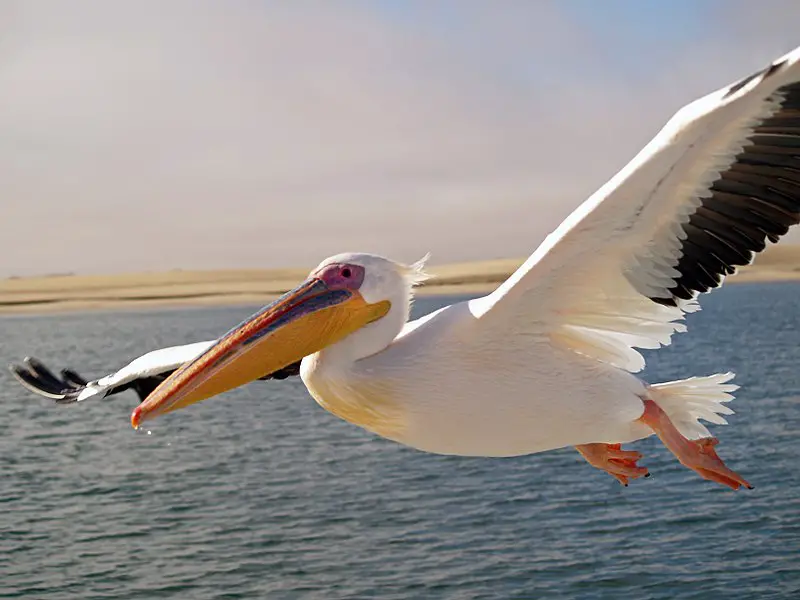
Pelicans are a large water bird and form part of the family Pelecanidae. They have long beaks, allowing them to scoop up prey from both land and sea with ease.
Their most distinctive feature is their huge throat pouch which they use to drain water before swallowing their food.
Most pelican species have predominantly pale plumage however exceptions such as the brown and Peruvian pelicans exhibit darker colouring.
The bill, face skin and pouch of all Pelican species become brightly coloured during breeding season in order to attract mates.
Pelicans can often live up to 25 years due to the fact that they eat mostly fish which provides them with enough nutrients for longevity.Scientific classification:
| Kingdom | Animalia |
| Phylum | Chordata |
| Class | Aves |
| Order | Pelecaniformes |
| Family | Pelecanidae |
| Genus | Pelecanus Linnaeus, 1758 |
Also Featured In: Most common birds in Australia, Sydney Birds You Need to See
33. Snowy Egret
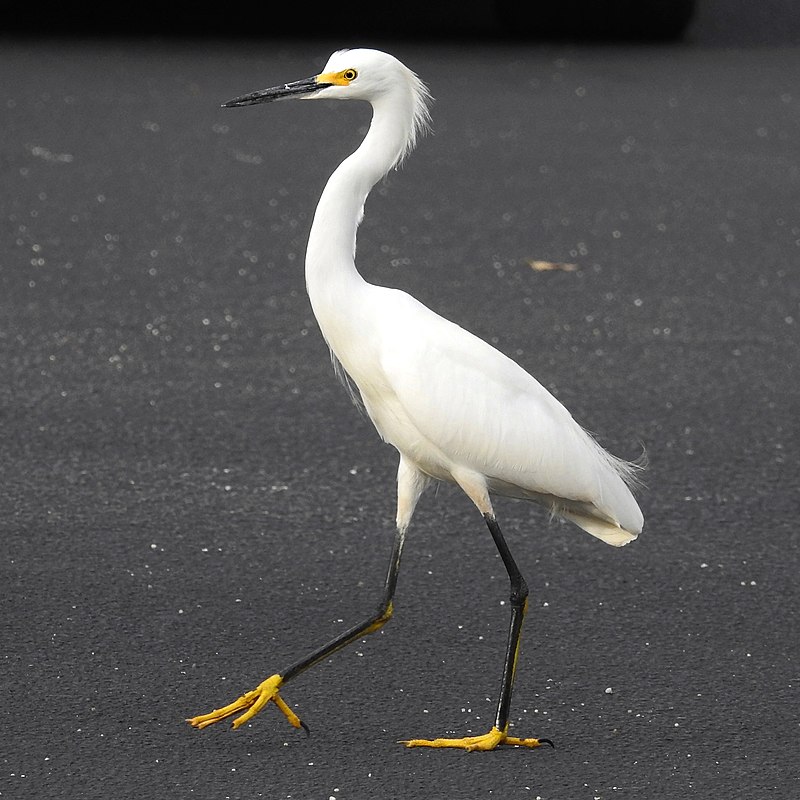
The Snowy Egret is a small white heron native to North America. Its scientific name, Egretta thula, comes from Provençal French for the little egret and an incorrect reference to the Black-necked Swan by Chilean naturalist Juan Ignacio Molina in 1782.
This beautiful bird has black legs with yellow feet, and a long plume of feathers on its head that often appears as if it’s wearing a crown.
It feeds primarily on insects and aquatic life like fish or frogs making it well adapted for both wetland habitats such as marshes or swamps plus coastal areas close to shorelines.
With their graceful movements they are truly delightful creatures to observe while out exploring nature.Scientific classification:
| Kingdom | Animalia |
| Phylum | Chordata |
| Class | Aves |
| Order | Pelecaniformes |
| Family | Ardeidae |
| Genus | Egretta |
| Species | E. thula |
Also Featured In: Trinidad and Tobago birds, Birds that Live in the Deserts
34. Buff-Banded Rail
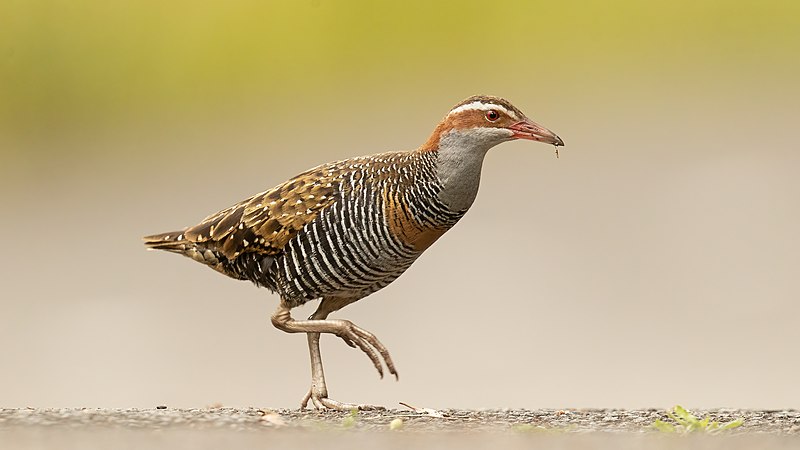
The Buff-banded Rail is a beautiful bird found across Australasia and the South West Pacific. It has distinctive black, brown, white and buff plumage which makes it easily recognizable.
Its long legs are adapted for wading in shallow water where it feeds on small fish, crustaceans, insects and vegetable matter.
This species is highly dispersive with some subspecies being found as far away as the Philippines (where they are known as Tikling) or New Zealand (known there as Moho-p).
With its adaptability to various habitats such as mangroves swamps, saltmarshes and farmlands; this species can be seen running around during low tide looking for food or hiding among vegetation when alarmed by potential danger.Scientific classification:
| Kingdom | Animalia |
| Phylum | Chordata |
| Class | Aves |
| Order | Gruiformes |
| Family | Rallidae |
| Genus | Hypotaenidia |
| Species | H. philippensis |
Also Featured In: Timor-Leste birds, New South Wales Birds You Need to See
35. Double-Crested Cormorant
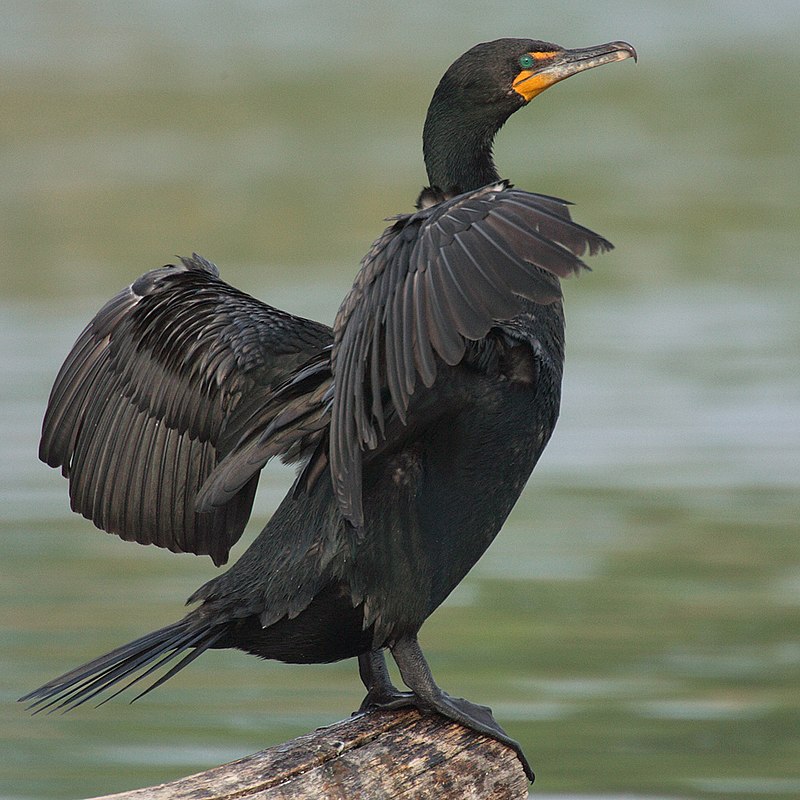
The double-crested cormorant is a majestic bird with an impressive wingspan, found across North America from the Aleutian Islands all the way down to Mexico.
Its black plumage stands out against its bright orange-yellow facial skin and some extended patches of white feathers on each side of its throat.
It measures between 28 – 35 inches in length and has webbed feet that enable it to swim gracefully through rivers and lakes, as well as coastal areas.
These birds are known for their voracious appetite for fish, sometimes diving over 100 ft deep into water looking for food.
Despite this reputation they also feed on crustaceans, amphibians and insects when available.
Cormorants have been part of many cultures throughout history due to their remarkable ability to fly long distances making them valued messengers or companions during fishing expeditions at sea.Scientific classification:
| Kingdom | Animalia |
| Phylum | Chordata |
| Class | Aves |
| Order | Suliformes |
| Family | Phalacrocoracidae |
| Genus | Nannopterum |
| Species | N. auritum |
Also Featured In: Cormorant Species, Birds that Live in the Ocean
36. Snow Goose
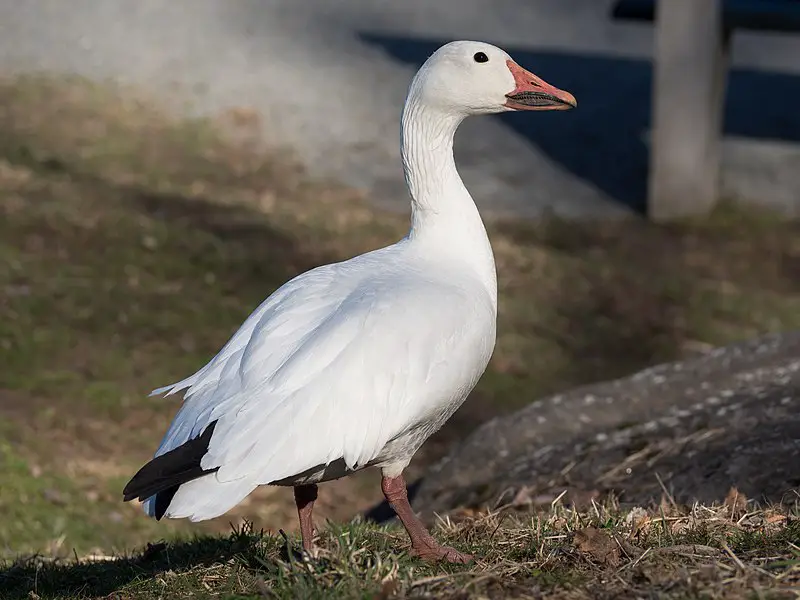
The snow goose is a species of goose native to North America, recognizable by its white or dark plumage. It belongs to the genus Anser, also known as the “gray goose”.
Snow geese breed north of the timberline in Greenland, Canada and Alaska – places with harsh climates that would seem inhospitable for such birds.
Yet they thrive here due to their migration pattern; when winter arrives they fly southwards along two major routes towards warmer climates like California and Mexico where food sources are more plentiful.
Although these graceful waterfowls have adapted well to human activity near some parts of their range, hunting still takes its toll on them so it’s important we do our part in protecting this species from extinction.Scientific classification:
| Kingdom | Animalia |
| Phylum | Chordata |
| Class | Aves |
| Order | Anseriformes |
| Family | Anatidae |
| Genus | Anser |
| Species | A. caerulescens |
Also Featured In: Utah Birds, Birds that Live in Vancouver
37. Sternidae
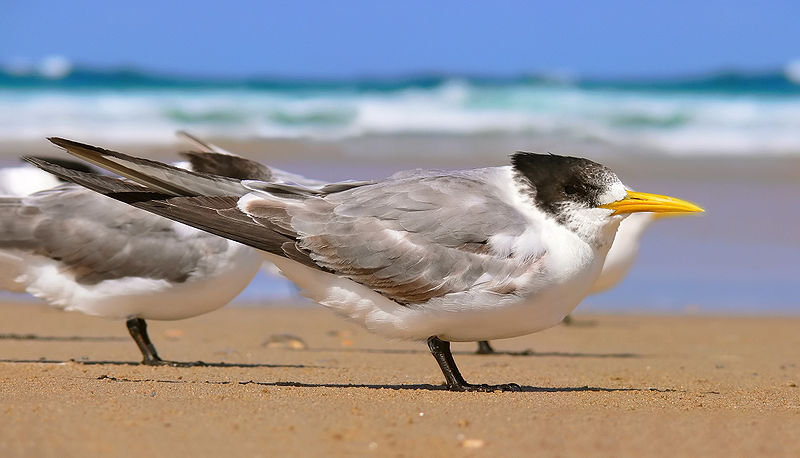
Sternidae are a subgroup of the family Laridae, consisting of eleven genera. They have slender bodies with long forked tails and narrow wings. Their bills are long and their legs relatively short.
Most species display pale grey or white plumage above, while underneath they show black markings on the head along with varying shades of browns elsewhere on their body.
These seabirds can be found in coastal areas near oceans, rivers and wetlands worldwide but especially in North America where they feed primarily on small fish which they capture by swooping down from the air to snatch them up from below the surface.
They also supplement this diet with crustaceans such as crabs when available.Scientific classification:
| Kingdom | Animalia |
| Phylum | Chordata |
| Class | Aves |
| Order | Charadriiformes |
| Family | Laridae |
| Subfamily | Sterninae Bonaparte, 1838 |
Also Featured In: Florida Birds, Birds You’ll Find in the Sea
38. Ruddy Duck
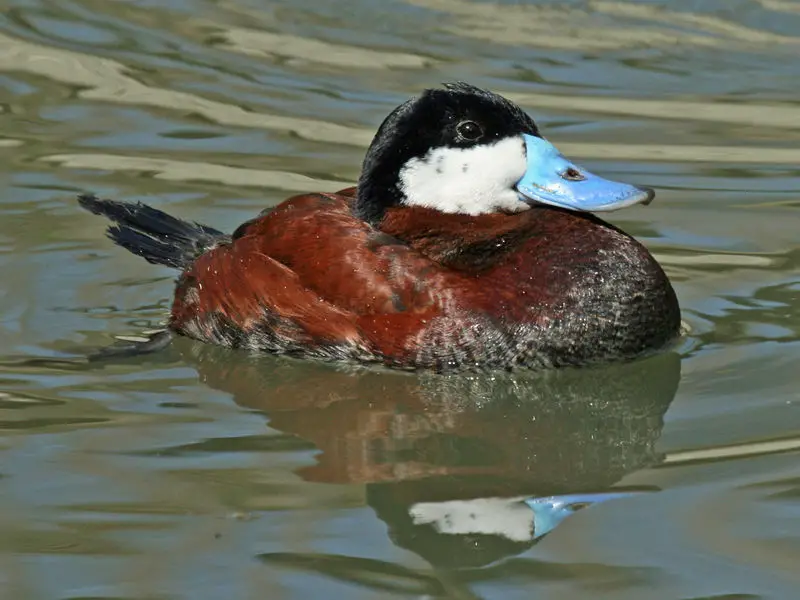
The Ruddy Duck is a North American species of duck native to Jamaica, known for its sharp tail.
It was formally described in 1789 by the German naturalist Johann Friedrich Gmelin and placed into Carl Linnaeus’ Systema Naturae.
These ducks are medium-sized with males having greyish cheeks and forehead, while females have brown heads. Both sexes also feature an orange bill with blue base and white patch on their faces near their bills.
In winter months they can be found inhabiting freshwater ponds, lakes or marshes where they feed mainly on aquatic vegetation like algae or small insects, mollusks or crustaceans as well as plant material from land nearby.
They tend to flock together during migration season when going southwards for warmer climates but usually remain solitary throughout other times of the year unless breeding which takes place between April-June each year involving nest building activities such as gathering materials for lining nests made close to water sources before laying eggs that will hatch after about one month�s time.Scientific classification:
| Kingdom | Animalia |
| Phylum | Chordata |
| Class | Aves |
| Order | Anseriformes |
| Family | Anatidae |
| Genus | Oxyura |
| Species | O. jamaicensis |
Also Featured In: birds of New Mexico, Most Common Lake Birds
39. Hooded Merganser
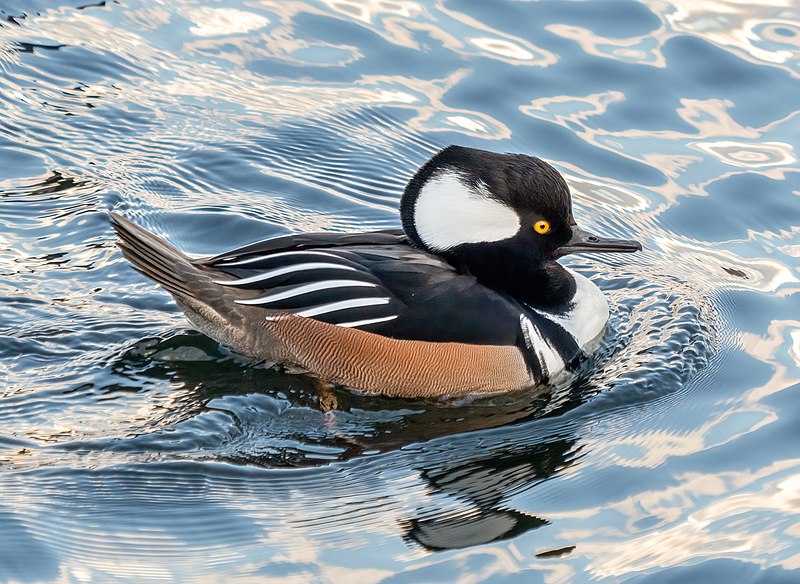
The Hooded Merganser is a beautiful and unique bird, belonging to the family of mergansers. It is easily recognizable due to its distinct crest which can be raised or lowered at will.
During breeding season, males have an impressive plumage with various colors and patterns that make them stand out even more.
They live near streams, ponds or marshes where they feed on aquatic insects, crustaceans and small fish by diving in from above the water surface with their wings open before submerging completely under it.
Their nesting habits involve using hollows created by other animals such as beavers for laying eggs inside tree cavities too close to water bodies so that they are well-protected from predators while still providing them easy access to food sources.Scientific classification:
| Kingdom | Animalia |
| Phylum | Chordata |
| Class | Aves |
| Order | Anseriformes |
| Family | Anatidae |
| Genus | Lophodytes Reichenbach, 1853 |
| Species | L. cucullatus |
Also Featured In: Wetlands Birds You Should Know, Birds in Pacific Northwest
40. Wood Duck
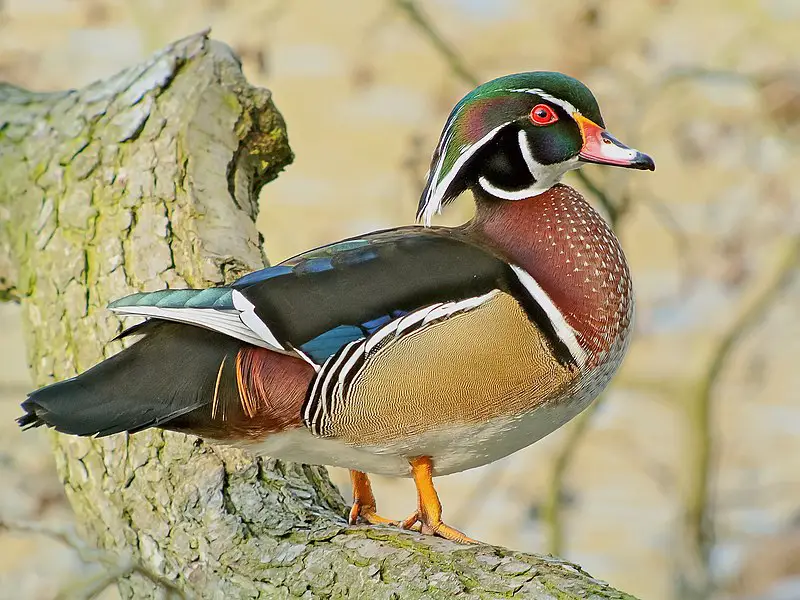
The wood duck, also known as the Carolina Duck, is a species of perching duck native to North America. It is renowned for its beautiful plumage and vibrant colors.
On average, an adult wood duck stands at 19-21 inches in length with a wingspan ranging from 26 to 29 inches. Its weight typically falls between 454–800 grams depending on gender and seasonality.
This medium-sized bird can be seen swimming or perched atop branches near bodies of water like lakes, ponds and rivers – where it feeds mostly on aquatic plants and insects.
The female builds nests inside cavities in trees close to these waters while the male protects her eggs during incubation period until they hatch into adorable little chicks.
Wood ducks are beloved by many due their stunning looks which make them popular subjects among photographers too.Scientific classification:
| Kingdom | Animalia |
| Phylum | Chordata |
| Class | Aves |
| Order | Anseriformes |
| Family | Anatidae |
| Genus | Aix |
| Species | A. sponsa |
Also Featured In: Common Central Park Birds, Common San Antonio Birds
41. Swans
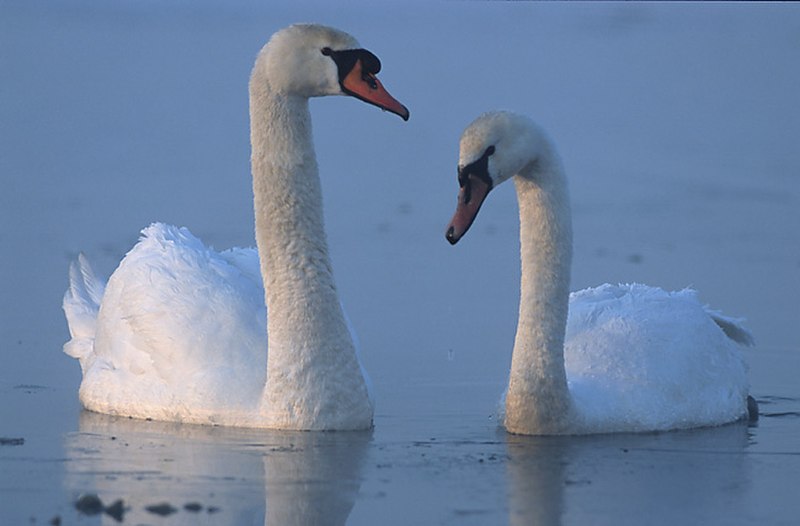
Swans are graceful and elegant birds belonging to the family Anatidae. They have a long neck, black beak and large wings that give them their majestic look.
Their closest relatives include geese and ducks who belong to the same subfamily Anserinae as swans do.
There are six living species of swan found in different parts of the world – Mute Swan, Black-necked Swan, Tundra Swan, Whooper Swan, Trumpeter Swan and Coscoroba Swam.
These beautiful creatures usually live on lakes or rivers but can also inhabit wetlands such as marshes or estuaries for nesting purposes.
Despite being very social animals with strong pair bonds they remain solitary during migration periods when they travel long distances looking for better feeding grounds.Scientific classification:
| Kingdom | Animalia |
| Phylum | Chordata |
| Class | Aves |
| Order | Anseriformes |
| Family | Anatidae |
| Subfamily | Anserinae |
| Genus | Cygnus Garsault, 1764 |
Also Featured In: birds of white, Famous Paintings Birds
42. Australian White Ibis
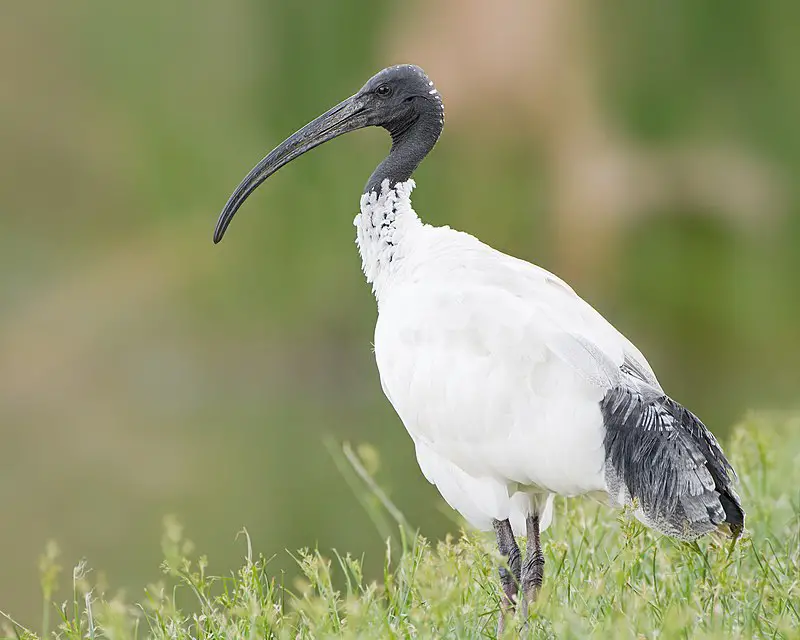
The Australian white ibis is a native wading bird of Australia. With its predominantly white plumage and long downcurved bill, it is easily recognized.
The bird is often found foraging for food on open grasslands, pastures and urban areas such as parks and gardens.
Despite being closely related to the African sacred ibis, the Australian white ibis is a separate species. It has a bare, black head and black legs.
The bird is well adapted to urban environments and often scavenges for food from waste bins or on streets.
While it has been subjected to negative perceptions due to its scavenging behavior, it remains an important member of the Australian ecosystem.Scientific classification:
| Kingdom | Animalia |
| Phylum | Chordata |
| Class | Aves |
| Order | Pelecaniformes |
| Family | Threskiornithidae |
| Genus | Threskiornis |
| Species | T. molucca |
Also Featured In: Birds that Live around Brisbane, Birds that Live around Victoria
43. Brown Pelican
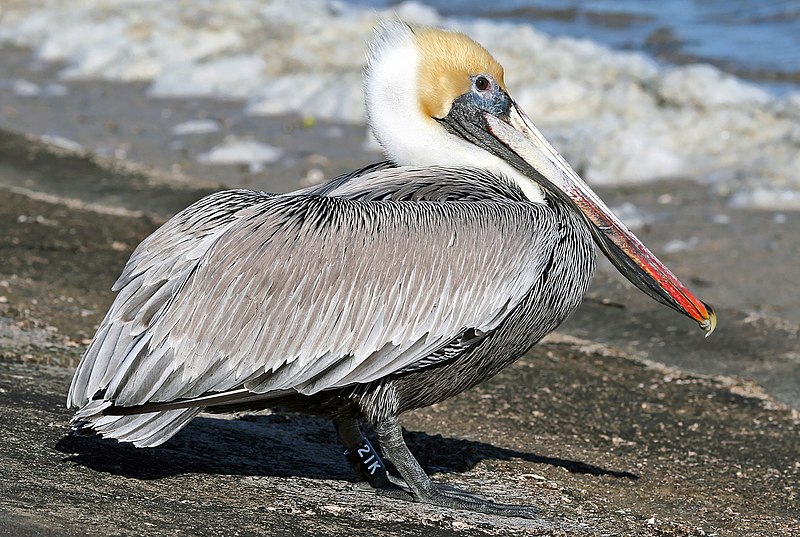
The majestic brown pelican is a dive-feeding bird that belongs to the pelican family. It is one of the three pelican species found in the Americas and is known to dive into water to catch its prey.
From the Atlantic Coast of New Jersey to the mouth of the Amazon River, and along the Pacific Coast from British Columbia to northern Chile, including the Galapagos Islands, this bird can be found.
Its scientific name is Pelecanus occidentalis, and it has a colored brown plumage, which is its distinct characteristic.
The brown pelican belongs to the largest bird species that exist today, with a wingspan that can stretch up to seven feet long.
This bird helps maintain a balance in the ecosystem by eating smaller fish, crustaceans, and other aquatic prey.Scientific classification:
| Kingdom | Animalia |
| Phylum | Chordata |
| Class | Aves |
| Order | Pelecaniformes |
| Family | Pelecanidae |
| Genus | Pelecanus |
| Species | P. occidentalis |
Also Featured In: Flight Birds You Should Know, Common Southern Californian Birds
44. Northern Pintail
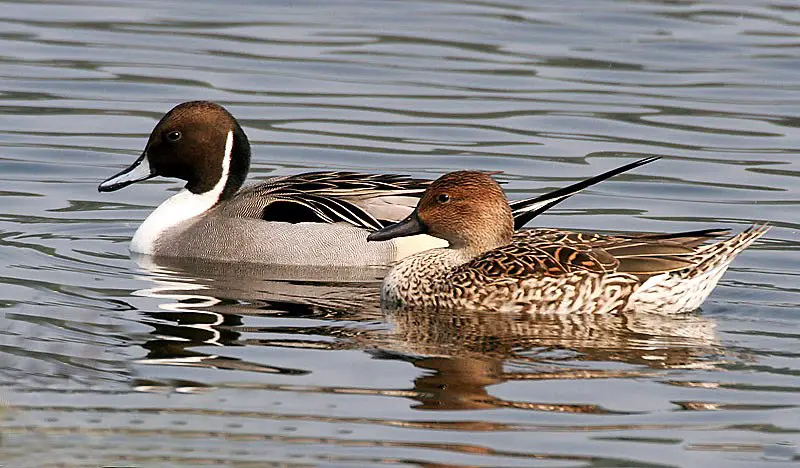
The Northern Pintail is a widespread duck species that breeds in northern parts of Europe, across the Palearctic and North America. This migratory bird winters south of its breeding range to the equator.
Unlike most birds with such a wide range, it does not have any subspecies. The male Northern Pintail has a distinctive long, thin tail and a chocolate-brown head. The female has a mottled brown body and a shorter tail.
This duck species prefers shallow wetlands or marshes for breeding and feeds on aquatic plants and insects.
The Northern Pintail is a highly migratory bird, covering great distances in search of suitable habitats.
Despite some threats, this species is not considered globally threatened, although certain populations are experiencing a decline in numbers.Scientific classification:
| Kingdom | Animalia |
| Phylum | Chordata |
| Class | Aves |
| Order | Anseriformes |
| Family | Anatidae |
| Genus | Anas |
| Species | A. acuta |
Also Featured In: British Columbian Birds, Birds that can be Seen in Outer Banks
45. Bufflehead
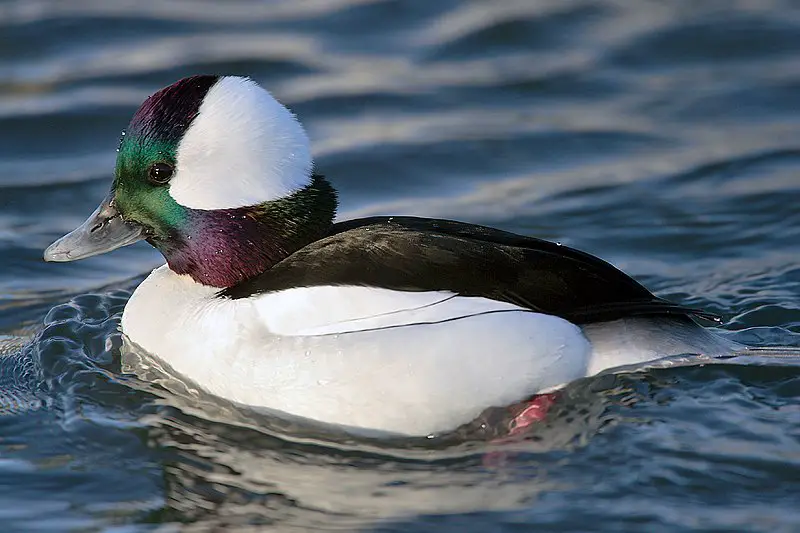
The Bufflehead bird is a small sea duck belonging to the goldeneyes genus. It was first described in 1758 by Carl Linnaeus, and its scientific name is Bucephala albeola.
The name “Bucephala” comes from the Greek words for “bull-headed,” which refers to its oddly shaped, bulbous head.
These birds are known for their striking black and white plumage, with the males sporting distinctive iridescent green and purple feathers on their heads.
Buffleheads are found primarily in North America, spending their winters on coastal waters and migrating inland to breed in wooded areas.
They are skilled divers and feed primarily on insects and small crustaceans. Despite their small size, Buffleheads are hardy birds and can survive in extreme weather conditions.Scientific classification:
| Kingdom | Animalia |
| Phylum | Chordata |
| Class | Aves |
| Order | Anseriformes |
| Family | Anatidae |
| Genus | Bucephala |
| Species | B. albeola |
Also Featured In: Estuaries Birds, Acadia National Park Birds
46. Common Merganser
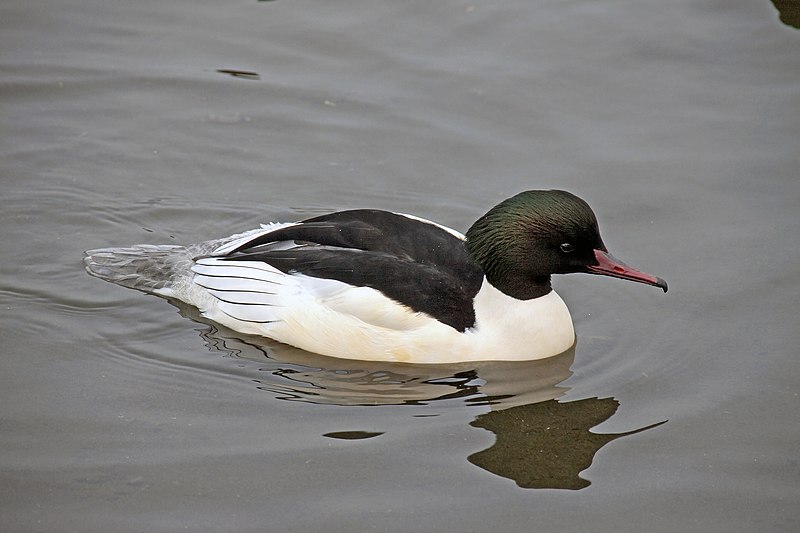
The Common merganser, also known as the goosander in Eurasia, is a notable seaduck found in river and lake habitats of forested regions across Europe, Asia, and North America.
This large bird primarily feeds on fish and is known for nesting in tree holes. It was first described by Carl Linnaeus in 1758 in the 10th edition of his Systema Naturae.
With its distinctive appearance and adaptability, the Common merganser is a fascinating species that has captured the attention of bird watchers and ornithologists alike.Scientific classification:
| Kingdom | Animalia |
| Phylum | Chordata |
| Class | Aves |
| Order | Anseriformes |
| Family | Anatidae |
| Genus | Mergus |
| Species | M. merganser |
Also Featured In: Birds Commonly Found in Northern California, Common Birds in Alberta
47. Anatinae
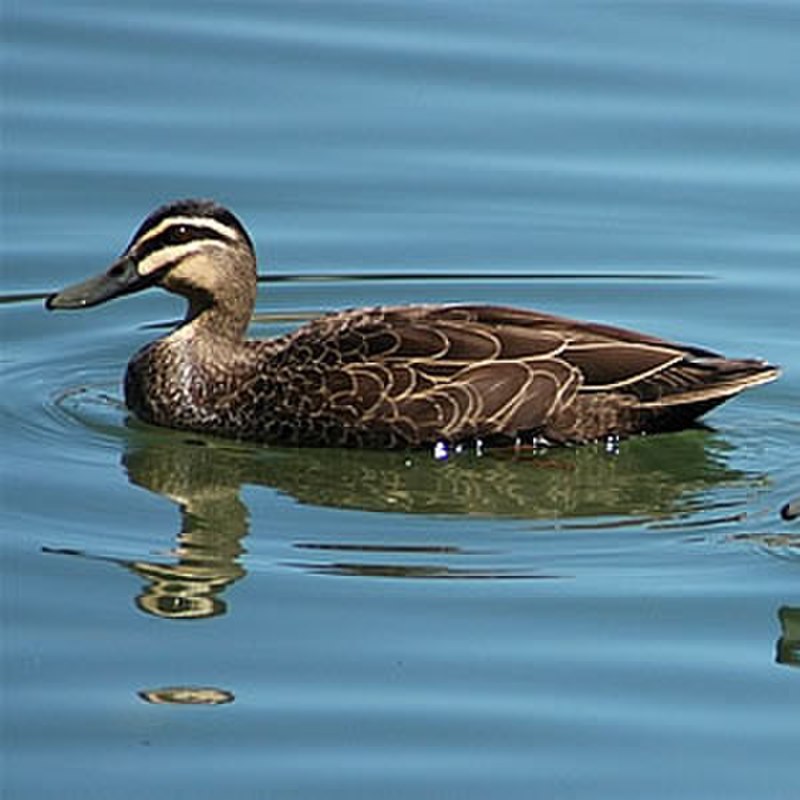
Anatinae is a subfamily of the family Anatidae, which includes swans, geese, and ducks. The surviving members of Anatinae are the dabbling ducks that mostly feed on the water’s surface.
The extinct moa-nalo belongs to the dabbling ducks’ lineage and is highly apomorphic. The systematical status of ducks within Anatinae is a widely debated topic.Scientific classification:
| Kingdom | Animalia |
| Phylum | Chordata |
| Class | Aves |
| Order | Anseriformes |
| Family | Anatidae |
| Subfamily | Anatinae Leach, 1820 |
48. Anhinga
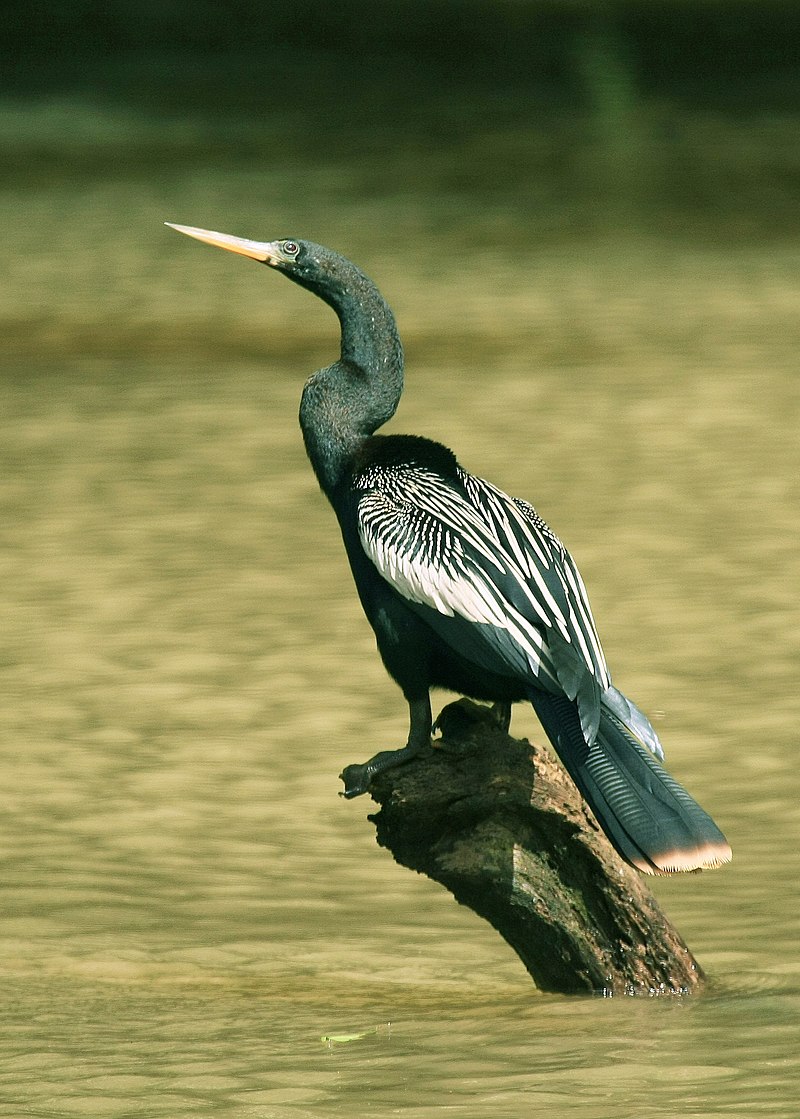
The Anhinga is a water bird found in the warmer parts of the Americas. It is sometimes called the snakebird, American darter, or water turkey.
The bird’s name comes from the Brazilian Tupi language and means “devil bird” or “snake bird.” When swimming, only the Anhinga’s neck appears above water, giving the appearance of a ready-to-strike snake.
It is a skilled swimmer and hunter, using its sharp beak to catch fish underwater. The Anhinga is easily recognizable by its long neck, sharp beak, and distinctive coloring of black and white feathers.
Its ability to dry its wings quickly after diving is unique among water birds, as it lacks the natural oils that make feathers waterproof.
The Anhinga is an important member of its ecosystem, helping to control fish populations and serving as prey for larger predators.Scientific classification:
| Kingdom | Animalia |
| Phylum | Chordata |
| Class | Aves |
| Order | Suliformes |
| Family | Anhingidae |
| Genus | Anhinga |
| Species | A. anhinga |
Also Featured In: Everglades Birds, Birds that Live around Central Florida
49. Moorhen
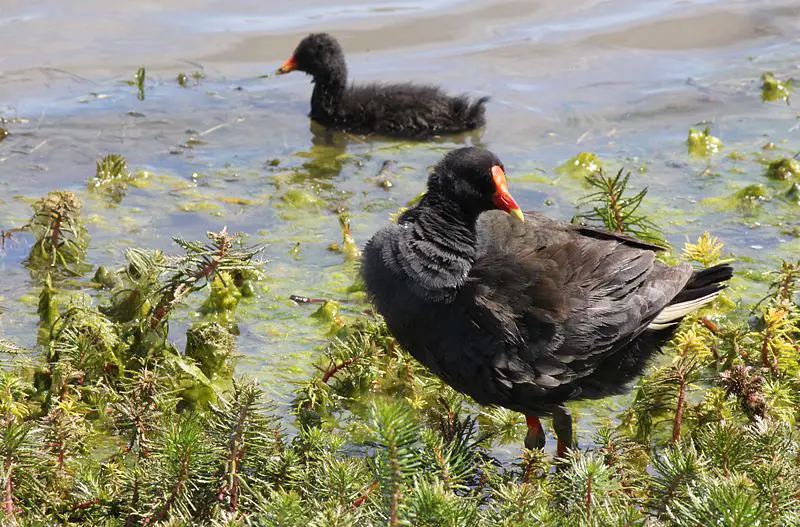
Moorhens are water birds that belong to the rail family. They are often called marsh hens and are medium-sized.
The Latin name for them is Gallinula, which means “little hen.” They are closely related to coots and are sometimes referred to as (black) gallinules.
One species of Gallinula was recently found to be different enough to form a new genus, called Paragallinula.
Moorhens are usually found near water sources such as lakes, ponds, and marshes. They have a black plumage and a red beak, and they are able to swim well.
They feed on aquatic plants, insects, and small fish. Moorhens are known for their territorial behavior and can be quite aggressive when defending their nests.Scientific classification:
| Kingdom | Animalia |
| Phylum | Chordata |
| Class | Aves |
| Order | Gruiformes |
| Family | Rallidae |
| Genus | Gallinula Brisson, 1760 |
Also Featured In: Birds of Kauai, Hawaii,
50. Common Moorhen
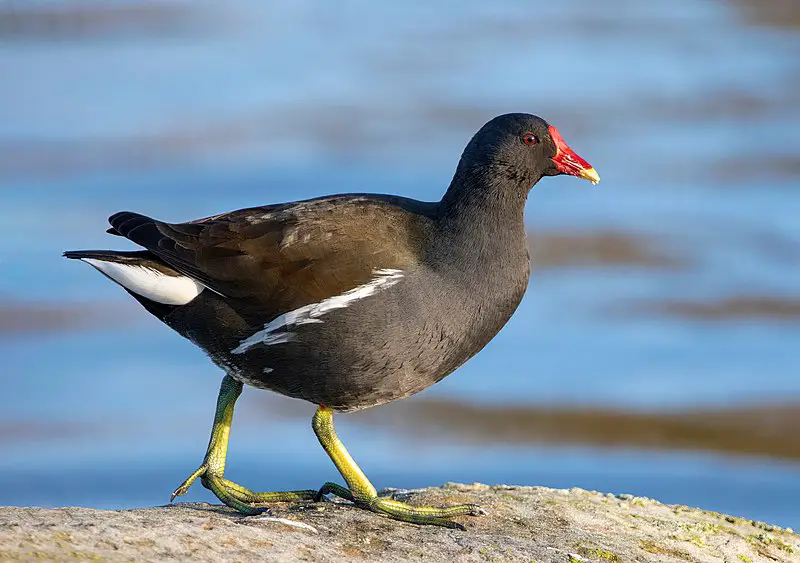
The common moorhen, also called waterhen or swamp chicken, belongs to the rail family and is widespread across various regions of the Old World.
These birds prefer to inhabit wetlands like canals, marshes, and ponds with rich vegetation. They are not found in polar regions or some tropical rainforests.
The species is known for its distinctive red forehead shield, which becomes more prominent during breeding season. Common moorhens usually feed on aquatic plants, small fishes, and invertebrates.
They are excellent swimmers and divers, but are also able to walk on floating vegetation. When threatened, they can flee by diving and swimming underwater.
Overall, common moorhens are fascinating birds that add to the diversity of wetland ecosystems.Scientific classification:
| Kingdom | Animalia |
| Phylum | Chordata |
| Class | Aves |
| Order | Gruiformes |
| Family | Rallidae |
| Genus | Gallinula |
| Species | G. chloropus |
Also Featured In: Birds that Commonly Found in Pond , Amsterdam Birds You Should Know
51. Eastern Great Egret
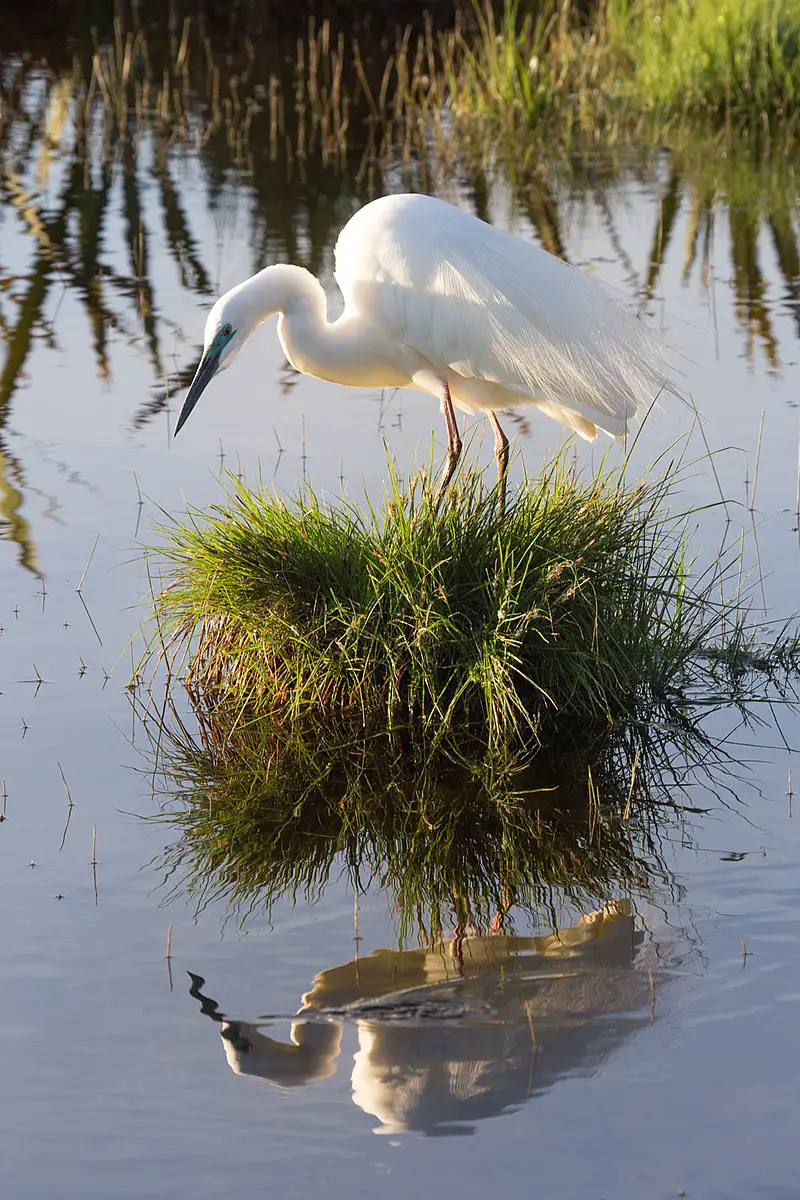
The Eastern Great Egret, also known as the White Heron or kōtuku in Māori, is a species of white heron in the genus Ardea.
It is typically considered a subspecies of the Great Egret and was first described by British ornithologist John Edward Gray in 1831.
This bird is native to India and has been described as a pure white heron. It is also found in New Zealand where it is highly revered by the Māori people.
The Eastern Great Egret is a stunning bird with white plumage and a slender body, standing up to one meter tall.
It is a skilled hunter, stalking its prey in shallow waters using its sharp beak to catch fish, amphibians, and other small animals.
This bird is an important part of many ecosystems and is a beautiful sight to behold in the wild.Scientific classification:
| Kingdom | Animalia |
| Phylum | Chordata |
| Class | Aves |
| Order | Pelecaniformes |
| Family | Ardeidae |
| Genus | Ardea |
| Species | A. alba |
| Subspecies | A. a. modesta |